#this is kind of a primer in itself in that if you only care about what i think is important then here you go
Explore tagged Tumblr posts
Note
hi :)) can you tell me anything about the london knights? i've been scrolling through the tag and i'm intrigued, they all seem so cute 👀 is there a primer, by any chance? - @bondedpairs
hi ! Im soo happy that you're enjoying them, theyre fun kids ! I ended up writing more than expected so please see under the cut <3
So the knights are a bit of a dynasty in terms of ohl teams. They've actually only won the memorial cup (best team out if all teams in the canadian hockey league) twice but if you look at the team awards. They were a bit of a powerhouse last year and swept a couple of their playoff series which is crazy. They're known for their player development and have produced a ridiculous amount of nhl players.
The sheer amount of nhlers that come from the knights is crazy, just the leafs for example have four currently on their roster in john tavares, mitch marner, max domi, anthony stolarz. The leafs president brendan shanahan is also an alumni. Other notable active alumni include nazem kadri (cgy), matthew tkachuk (cats), nikita zadorov (bos), bo horvat (nyi) and others but genuinely there are too many to list.
I am obviously leafs brained so if you want to talk about the mitch marner easton cowan parallel then welcome to the club! Cowboy first of all is beloved, drafted 28th overall by the leafs and largely considered to be a flop pick by the media, went on to put up a 96 point in 56 game season, as well as a 36 game point streak setting a new franchise record and winning ohl mvp. He then went on to score 34 points in their 18 game playoff run winning mvp for the playoffs as well. He is the first player to win both regular season and playoff mvp in the same season since mitch marner. He is an alternate captain this year, and made canadas world juniors team last year, and I love him.
Other notable players (TO ME) include:
Denver barkey: drafted in the 2nd round by the flyers 2023. NEWLY MINTED CAPTAIN 🫡, darling boy with the face of a doll. Was selected to be part of a collaboration with snoopdog and nhl enforcers??? has he ever won a fight? No.
Oliver bonk: drafted 22nd overall by the flyers 2023, assistant captain, and part of the 2024 canadian world juniors team. His dad played In the nhl for 14 years ! Noted worst aux on the team but seemingly unaware. Just seems very sweet and I like him :)
Sam Dickenson (number three london knights): drafted in the first round by the sharks but bc they also got mack this year he was kind of overshadowed. They also don't have anything linking them like a team usually would push for, probably bc of the fwd/defence divide and also bc mack already got a government issued boy best friend in will smith. I love him though, he was their baby last year and he's a brat bc of it. heart and soul of the teams social media
I unfortch dont have a primer or anything as im a more casual enjoyer but a couple of other ldn knights friends are rick @cashewbenoit and @antrea if you want more posts about them <3
These are some of my favourite knights things but if you've gone through my tag you've probably seen them
Who has the worst aux?
Carpool karaoke
Cowboy decorates a gingerbread house (ft mints of mapleleafs fame)
Hope you enjoy !
#sorry this took so long i was at work 😣#anyway if you want to know more reach out to me or rick who is SUPER knowledgeable#this is kind of a primer in itself in that if you only care about what i think is important then here you go#asks#london knights#*#bondedpairs
9 notes
·
View notes
Text
Hopepunk Primer pt. 2

Philosophy of Hopepunk
I cannot express this better than other people have done before me. So I'll start with an interview Kayti Burt had with several hopepunk authors in 2019.
"What is hopepunk? It depends on who you ask…
Rowland, quoting their essay “One Atom of Justice, One Molecule of Mercy, and the Empire of Unsheathed Knives,” says: “Hopepunk is a subgenre and a philosophy that ‘says kindness and softness don’t equal weakness, and that, in this world of brutal cynicism and nihilism, being kind is a political act. An act of rebellion.’”
To understand hopepunk as a concept it helps to understand what it stands in contrast to. Grimdark is a fantasy subgenre characterized by bleak settings in which humanity is fundamentally cutthroat, and where no individual or community can stop the world’s inevitable decline. Hopepunk, in contrast, believes that the very act of trying has meaning, that fighting for positive change in and of itself has worth—especially if we do it together." [4]
When Alexandra Rowland was asked on Tumblr to expand on the initial statement she made they elaborated:
"Hopepunk says that genuinely and sincerely caring about something, anything, requires bravery and strength. Hopepunk isn’t ever about submission or acceptance: It’s about standing up and fighting for what you believe in. It’s about standing up for other people. It’s about DEMANDING a better, kinder world, and truly believing that we can get there if we care about each other as hard as we possibly can, with every drop of power in our little hearts." [5]
I also love the definition of the Tumblr blog @hopepunk-humanity:
"What is Hopepunk?
Wild laughter from ragged throats
Flowers growing choked from crumbling asphalt
A warm bed after a long, hard journey
Your partner’s hand cupped in your own
Bright graffiti on cracked tunnel walls
The chains falling loose to the stone floor
A glint of silver beneath a century of tarnish
A long rain after a blistering wildfire
Just one more step, and then another
A single candle flame joining the stars against the night
A loved ones voice calling your name after hours lost in an unfamiliar place
A hand taking yours, just when you’d given up on reaching out
Smiling, laughing again, when you thought you’d forgotten how
Knowing, despite everything, that humans are inherently good
It’s not simply blind optimism, or naivety. It’s choice. It’s taking the human race by the hand and saying, “I will love you, because I am you”. It’s facing a world dripping with cynicism and fashionable hopelessness and saying, “no, I will not give in”. It’s putting kindness out into the world, knowing you might not get it back, knowing you may be scorned for it, knowing it might not change anything, but with a certainty that kindness is what the world needs the most.
It is choosing hope" [6]
Hopepunk is choosing hope in a world where they want us to have none. It's choosing humanity when they want us to forget we are human. It's choosing community when they would benefit of us staying individuals. It's choosing action and hope when they want us struck down and paralyzed.
Alexandra Rowland emphasizes to not forget the second part of the word: Punk. In another interview with Kayti Burt for Den of Geek they say:
"it’s important to remember that punk is the operative half of the word – punk in the sense of anti-authoritarianism and punching back against oppression." and "The instinct is to make it only about softness and kindness, because those are what we’re most hungry for. We all want to be treated gently. But sometimes the kindest thing you can do for someone is to stand up to a bully on their behalf, and that takes guts and rage." [7]
What is Hopepunk to me?
That spark that is both love and spite that keeps me going. It's seeing the good in humanity, while also acknowledging the harm. It's refusing to lay down and die, refusing the accept the status quo, refusing to believe that this is it.
It's believing in a better world. In kindness. In the inherent sense of community in humanity. It's believing in the power of stories.
It's seeing kindness and hope as an act of Sacred Rebellion. And spreading that kindness and hope is a Vow that I have taken.
It's taken the anger I have against corporations, injustice, bigotry, capitalism, oppression, and letting it fuel the fire within me in a constructive way. It's working to dismantle systems that are oppressive to work towards a more inclusive world. It's pruning the garden of dead weight so new things can grow.
Late stage capitalism wants us all to be docile, to work, not to live. So I will shout my small joys from the rooftops. I will create for the sake of creating. I will practice radical acceptance so that I stand strong above the masses of ads that wants me to hate myself. I will choose to see the good so that I can believe change is possible.
Hopepunk a fire that says "Rage. Rage against those who deserve it. Stand up for those who do not and show them a better world is possible."
[4] Den of Geek - Are you afraid of the darkness: a hopepunk explainer
[5] Alexandra Rowland tumblr post
[6] Hopepunk-humanity - what is hopepunk
[7] Den of Geek - a hopepunk guide: interview with Alexandra Rowland

Part 1: Intro and history
Part 2: Philosophy of Hopepunk
Part 3: How to practice hopepunk and further reading
Part 4: Extra! Hopepunk and magic
454 notes
·
View notes
Text
A Primer for the Small, Weird Loves.
Pairing: Connor Roy x Reader
Rating: Mature (Minors DNI, 18+)
Warnings: Mentions of sex, but no explicit detail, existentialism, the usual sort of trauma that seems to follow this man around, hurt/comfort
Word Count: 745

He has grown quieter in the aftermath of the end of the world; content to keep to himself and stay out of the way. It's not a very good story, and it's not a particularly new one. Everything has changed, and yet nothing has. Willa left only a few months after the wedding. The only reminder of an asteroid after impact is the crater it leaves and the stories of the people who saw it. What a sad little fate, to only be remembered for the holes you leave in things. Moths, for example; we take them for granted until they're eating the sweaters in our closets, and then they're more of a nuisance than something beautiful just trying to live their lives.
He is just trying to live his life.
You had been an unplanned development in the story. You'd fallen into his life like you'd meant to land there - on purpose; so few things are deliberate for him. You had approached him at a bar not too far from his ranch in New Mexico, had said you liked his eyes. The way they looked kind of sad, like he was missing something. You told him you hoped you could help him find it, whatever it was. That was seven months ago. Every day he worries you are going to leave. You don't. You move in with him.
On purpose. I am going to love you on purpose.
"I've never really understood poetry." He says, like it doesn't tear him up inside that someone would feel that way about him. Like his heart isn't a war zone, shrapnel on the inside, the wound still weeping and all the lights off.
"It's from a book, I think." You say, because you can bring him to water, but you cannot force him to drink. Fear drives us away from comfort, makes us think we don't deserve it.
He hums in acknowledgement and goes back to slicing the tomatoes on the cutting board in front of him. He's careful, quiet. The knife does not slip. He is still scared it might, even after it has been set to the side, tucked into the sink. Like it might grow sentience and choose to dig itself into the meat of his palm just for the hell of it. 'Who is this asshole, using me to cut up the things he likes into pieces?'
─── ・ 。゚☆: .☽ . :☆゚. ───
You're having sex when it hits him, that resounding, thunderbolt sort of clarity that only happens every once in a great while. He's on top of you, his hands on either side of your shoulders. Disheveled, his hair sticking to his forehead, his lips spit-slick and swollen. And he stops - looks at you like he's seeing you for the first time. Really seeing. Knowing someone, wholly and completely.
His hand shakes as he brings it up to cup your cheek, his thumb swiping over the ridge of your cheek bone. The sadness in his eyes is gone, now, in this moment. Replaced by something softer, and a heat, burning at the center of it all like a pulsar.
"On purpose." He murmurs. The words taste unfamiliar on his tongue.
"Yeah, Con." You let yourself smile a little, looking up at him with a dewy sort of wonder. Watching Selenicereus grandiflorus bloom in the pale moonlight. "On purpose."
He kisses you, then; softer, slower. Purposefully. His hands finding your own, lacing your fingers together. Sweet. He is sweet. He always has been, you think, he just had to find it in himself. You helped, in the ways you could. Salve on the bruises, lips on his knuckles. You cannot undo the past - cannot draw the hurt out of the wound with your mouth like sucking the venom from a snakebite. But you can see the holes in your sweaters, and you can remember the creatures that left them there. You can know him to be more than a frustration. Because he is. So much more than that.
He's learned to swallow down bile with the best of them. That sour ache on the edges of your tongue, tingling in its aftermath; makes the backs of your teeth ache, makes your fingers itch. The shoes and the waiting and the dropping. First, then second. Shit always hits the fan eventually - this is real life, there are certainties.
The meteor hits the ground. It leaves a bruise.
We can still build monuments.
26 notes
·
View notes
Text
Prison in the world of Cars
So Im currently in the process of writing chapter 8 of Behind Blue Eyes and said chapters' content has got me thinking about the various minutiae of prison systems within this universe. Here is my take on it.
Speed restrictors - In order to prevent any kind of escape attempt, speed restrictors would be fitted to inmates with a high flight risk to prevent any speed being reached above about thirty miles per hour. In some cases, it could be deemed necessary to decrease speed potential even further for the most dangerous offenders. But the use of these devices comes with a significant quantity of government regulation to prevent their misuse. The fitting of restrictors can cause engine issues in the long run and shouldn't be used without prior approval from a court.
Parking boots - Wheel cuffs. I needn't say much more than that. No moving for you! They can be used on both front wheels, both back wheels or all four wheels depending on requirement. But one or three parking boots should never be utilised as this can cause serious damage to the detainee if they were to try and drive.
Extension restraints - For particulary strong and violent offenders, axle extension restraints can be applied. Parking boots are the go-to for prisoner transport, which are heavy and cumbersome. But for strong vehicles who want to get a few punches in, the use of parking boots can be particularly hazardous to police officers. So these restraints can be utilised to prevent any damage to other vehicles or property that could be caused by the detainee.
Deep tread tyres - It would be damaging to a vehicle to force them to roll around on tyres with deliberately low pressure. So to increase drag for inmates, a thicker tyre tread is used. This has the added bonus of reducing the amount of replacements required during sentence duration, thus cutting down on costs. Although the tyres used increase the vehicles ability to grip into the floor and push or pull, the officers that respond to any issues with the prisoners within their care are usually able to subue them rapidly and effectively. Prison tyres are ugly and not comfortable to drive on.
Chemically engineered paint - With technological advancements and genius chemical engineering, the paint used on inmates is very specific and can be picked up from quite a distance away with the use of police scanners. It holds its own unique chemical formula that lights up like a christmas tree when scanned with the appropriate digital equipment. The colour is also utilised as a tell-tale sign as it is a highly distinctive and vibrant orange; the only orange paint of its kind. This paint can only be purchased for prisons, by prisons. To be in possession of this paint without the appropriate licensing carries both a hefty fine and a prison sentence. So if an unlicensed vehicle is caught with it, they will very quickly be wearing it. The chemical does, however, hold the unfortunate capacity to seep into and embed itself into the surface of metal through layers of paint, meaning that, even if a vehicle is released and repainted (repainted on the offenders dime might I add), they will still be picked up on police scanners. This leads them to be regularly stopped and questioned by police officers. This can be incredibly irritating to both parties, however it does allow officers to keep an eye on offenders that are on probation. Vehicles that are permitted to be external to the prison whilst on remand are sprayed with just the traceable chemical component of the paint, which is invisible to the naked eye. A small stencil is utilised in the form of the sigil of the police force that made the arrest. This makes them traceable to police, but prevents civilians from seeing that said vehicle could be facing criminal charges. For those that can afford the expensive procedure, this chemical is removeable by removing all layers of paint and primer and grinding down the surface layer of the bare metal. This can be painful, so a general anaesthetic is provided.
Fuel quantity control - As previously displayed in the first cars movie, fuel quantity is important when you want to try and escape from the cruel clutches of community service. The same principal can apply in prisons. Fuel intake is heavily regulated and no inmate is usually permitted any more than 1/8 to 1/6 of a tank at any time. There are exceptions to this in regards to specific jobs that inmates perform as some will require larger quantities to perform their duties. Which is usually met with seething envy.
GPS locators - This method is even more heavily restricted than the use of speed restrictors as it violates multiple data protection laws and vehicle rights legislation. However, in the correct circumstances, it can be very useful. This is only ever used for vehicles that are both incredibly dangerous and have a high flight risk.
Remote engine inhibition - A vehicles engine can be shut down at the push of a button after modifications to the programming of the ECU have been made. This method of inmate control is incredibly new and still in its theoretical stages and thus it is still being debated whether or not it is viable and vehmane. Considering its highly intrusive nature and possibly damaging consequences to both the escapee and the general public, if it were ever to pass into legislation, its useage would be very rare indeed.
Medical care - Each vehicle within the prison system must have a three monthly check up with a desigated mechanic and all new inmates must be checked once a week for the duration of three months. Considering high depression rates within prison systems, a lot of vehicles, especially first time offenders, will stop consuming oil due to stress. This can lead to sickness and fever/overheating, which causes severe issues in the long run.
Not all of the above restraint/tracking methods will be used in all cases as it will depend highly on sentencing requirements for specific individuals and the type of prison that they end up in.
I might update this at a later date if I think of anything else to add. But so far, this is all I've got.
In a nutshell, its INSANELY difficult for any vehicle to escape a prison. So Miles Axelrod is pretty fucked.
#pixar cars#cars fandom#cars#cars pixar#cars headcanons#cars 2#cars 3#miles axlerod#prison for vehicles#vehmane is humane but for vehicles#i dunno man#i tried#new fandom word maybe?#does it even make sense?
68 notes
·
View notes
Text
Gay OK Bangkok

Well, holy shit. I had been planning to watch this ahead of Only Friends because @shortpplfedup named it as one of the Jojo shows that would serve as a good primer for the types of themes we could expect. I didn’t know much about it except it was an Aof/Jojo collab and had openly queer cast members. I expected something like a short Thai Queer as Folk.
And it kind of is like QaF, in the sense that it’s very much a show about a group of queer friends and their romantic (mis)adventures that features frank discussion of gay sex and sexual health practices, but it’s not really like it at all in terms of its tone. Where QaF is known for its explicit sex, trippy drug sequences, and heavy doses of camp, GOBK is much less smutty and has a thread of deep melancholy running through it (oh hi Aof), and it is primarily interested in doing some serious character work alongside delivering its messages about safe sex. And these characters got their hooks in me much more than I expected.
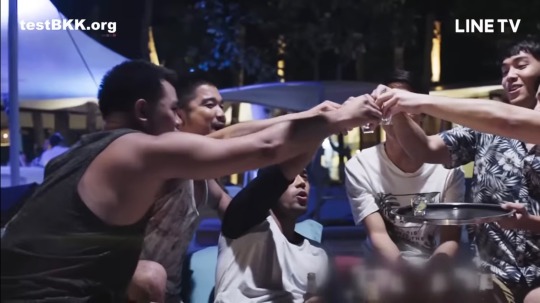
I think what I appreciate most about this show is how real the characters feel. They’re wonderfully flawed, fully realized human beings—beautiful and ugly in equal measure, wrong as often as they’re right, and just doing their best to balance their needs and desires with how they want to show up for the people they love. Even the characters I didn’t like much, I still understood and felt some empathy for, and I think that’s a credit to the compassion and care with which this series is written (not a surprise given Aof and Jojo are the ones who wrote it). Everyone gets the benefit of nuance and grace, including the side characters. And to be clear, I wouldn’t consider this a bl. I’d call it a queer slice of life drama that includes romance, but is not about romance—there is no primary romantic relationship that acts as the plot driver and it’s not at all interested in happily ever afters or even firm endings for its relationships.

My only real complaint about this show is I wanted (a lot) more of it. But still, for a show that only had eight hours total runtime over two seasons, it managed to do a lot with it. I am going to avoid getting into spoilers because as usual, I want y’all to watch this! But I really loved seeing a few years in the life of Arm, Pom, Aof, Big, Sathang, and their various friends, family, and lovers. And, crucially, it’s all so very queer. There is so much to unpack here about the nature of loneliness and desire and the guilt and shame that often comes along with them. The show is interested in exploring lots of ways to be in love and in relationship with each other, and it lets the characters fight, fuck up, break up, make up, and express their own confusion and discomfort and dissonance along the way. The only thing it’s interested in being preachy about are safe sex practices; everything else is presented in shades of gray. And it doesn’t limit itself to romance; we see the characters at work and with their families and out living their daily lives in a society that is often actively hostile to them. This show sits squarely at the center of @wen-kexing-apologist’s by/for/about Venn diagram (can’t wait for you to watch this, friend).
I highly recommend this show to anyone who plans to watch Only Friends (which, by my count, is just about everyone I know on here)—homework is of course not required before enjoying a new drama, but I do think familiarity with this work will enhance your experience, and it’s such a quick watch! If you’re interested, the show is available on YouTube here and here. It also has a great and surprising soundtrack which has also been compiled into two playlists.
Tagging friends @neuroticbookworm, @waitmyturtles, @chickenstrangers, and @lurkingteapot who are all in the midst of their own watches or planning to start soon, and @bengiyo, @so-much-yet-to-learn, and @imminentinertia who saw this awhile back and shared some interesting reflections about it during my watch.
135 notes
·
View notes
Note
Not sure if you've already covered, but steel type care?
Since my previous type guides are STILL missing (I spent soooo long formatting them :[ fuck my liiiiiife) I'll give a quick run-through here. This post will go over steel type misconceptions, general care, and then some specific examples from Mirror (my friend Tay's absolutely precious Mawile) and Kororā (my koro's Empoleon)
Firstly, while "Steel" is the term we commonly use, Steel type Pokemon can be made of a wide range of metals and alloys! Unfortunately I'm not fully up to date on all the science there (I can barely work a bunsen burner) but when caring for your Pokemon the number one thing you should do- first and foremost- is learn what they specifically are made of. This extends beyond steel types, learning what kinds of feathers or furs or liquids make up your Pokemon is important to make sure that you can care for them in the way they need!
Additionally, many steel types aren't fully metallic. Some definitely are, but others may only have specific metallic elements to them that require specific care. For example:
Mawile have metal "teeth" in their back horn(s).
Empoleon have a metallic crests/horns and metal edges around their wings.
Both of these Pokemon have different considerations to keep in mind while caring for them. Mirror tends to only require what some would consider dental care, applying protective and strong coating to the teeth to keep them in good shape and allow her to bite easier. Kororā, meanwhile, is in his older years and so sometimes he requires sharpening on his wings (and alternatively, wing-caps for when he's not doing his work- koro got him custom ones and he likes them so much that sometimes it's a fight to get him to take them off) along with polishing his crest.
The FIRST thing to learn about steel type maintenance is corrosion and rust. While most steel types are able to regenerate themselves over time, extensive damage needs to be seen to. A good comparison for humans is tooth decay. Enamel can repair itself but if the teeth aren't in good shape and aren't seen to for a good while it can weaken and lead to a cavity.
Of course, just like with teeth, each Pokemon's "steel" is different. Some are simply more durable, some are more vulnerable to certain conditions, it happens!
When looking over your steel types, make sure to check their metallic parts and look for either pitting (small pockets of corroded metal) across the metal, or corrosion along the edges. Rust tends to be more obvious.
Corrosion happens due to a range of metals that can be in Pokemon (iron, copper, etc)
As a side note, copper oxidization can actually increase durability, though make sure to inspect primarily copper/copper-alloy Pokemon regularly. (Sadly I've never gotten to groom a Cufant or Copperajah, but there's always hope for some day!)
In general, corrosion can relate to environments with heavy moisture content or just if your Pokemon loves to swim. AGAIN, some steel type Pokemon have metals that are suited to the water, so it depends on which mon you're working with.
Safeguarding against this corrosion can really depend on what you have access too, professional steelworkers will often galvanize their steel types in a bath of molten zinc (I got to watch this once, the HAPPIEST Arons I've ever seen). There are a range of products that the average trainer can use at home, chemical coating spray or zinc phosphate primers are all wonderful options. Make sure to check which formula has the best results with your specific Pokemon and then apply the paint or primer to a small section of their coat to check for any kind of adverse reactions.
Make sure to use sulfate-free cleaning products on your steel types!!!!!!!!
And my final note, make sure to pay attention to the ENTIRE Pokemon. Don't just tend to the metal, give the rest of them a good scritch or a brush or a wash. Show them that you appreciate all of them and trust me, they'll appreciate you too.
I think that's all I have for an overview. I wish that I could upload some of my old videos again, it'd be so much easier to explain if I could show ya'll...
But until then, I'll just keep posting information from Pallas' Perspective. Tune in next time~
6 notes
·
View notes
Text
Okay, I could talk about each of these topics in greater depth, but I'll keep it boiled down or else I'll be typing for a loooong time. If anyone wants elaboration on the following steps or on any particular pieces I've done, let me know and I'll give more tips and tricks later :) Apologies for the formatting, I'm still getting used to posting on Tumblr
-------------------------
Step 1: Clean up and prep I start by sanding down leftover pieces and flaws in the model caused by the production process. In traditional model kits, these are pour tabs, flash and seam lines. For 3D printed, these would be pits or bumps left behind from supports and layers lines.
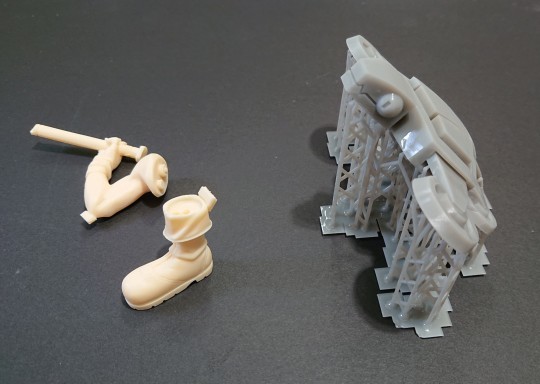
The arm and boots on the left are from a traditional model kit, and have visible tab chunks that will need snipping then sanding. S.H.E.L.L.D.O.N on the right needs his supports removed, then sanding. Every piece (minus those with fine texture) gets buffed with 240, 320, 600 and 1000 grit sandpaper/sanding sponges (clear parts and any pieces intended to be painted with clear paints, such as character skin, are additionally polished with a melamine sponge, also known as a magic eraser).
This is to make sure the surface is level and uniform. Any bumps or scratches that aren't removed will show up in the final paint job.
(Note for beginners: It's fine to just remove production remnants and do a little clean up before going to the next step. All that prep is tedious! Just have fun with it for now!)
Step 2: Make sure the model parts fit well together. It's very common for a model to not fit together perfectly right away. Dipping the model in hot water to soften it, then pressing the pieces together usually fixes this. Be careful not to burn yourself! Sometimes drilling and sanding is required. At this point, larger model kits will require drilling and pinning, though most are fine being assembled later just with glue.
Step 3: Primer
I secure the pieces on clips to keep them elevated, and spray them in thin, even layers of primer. Primer is essential, as it is what makes the paint stick to the model. - White primer: Best for anime and cartoon figures, makes colors pop - Grey: For realistic characters, dulls colors down a little. - Black: For metal or specialty products, like Armored Komodo pigments
Primer will make any unresolved blemishes become more visible, so I usually go back to step 1 until I get them all.
Step 4: Clear coat
For an even, level paint job, I spray a layer of Gloss clear coat on every piece, to smooth the surface even more. I skip this for finely textured pieces, so the details don't get filled in. Spray in a well ventilated area with protection!

There are many brands of clear coats. These are my favorites!
Step 5: Paint
I use three kinds of paint:
Lacquer: Expensive, take a little while to cure, must be thinned with a solvent. Sometimes hard to find. Offers lovely effects, is durable and sticks very well. Can be difficult to correct if something goes wrong. *HAZARDOUS, use in a well ventilated or outside area and use breathing protection!*
Enamel: A little easier to find, takes a long time to cure, which sometimes is a benefit, as it can level itself and provide a smoother surface. Must be thinned with a solvent, sticks very well. Most importantly, enamel can be used on top of lacquers and erased without damaging the lacquer layer. *HAZARDOUS, use in a well ventilated or outside area and use breathing protection!*
Acrylic: Great, vibrant colors, easy to find, very affordable! Dries very fast, even faster if you lightly use a hair dryer. Very delicate, prone to scratches and chips. Can be easily stained by other acrylic color. You only need water to thin it!
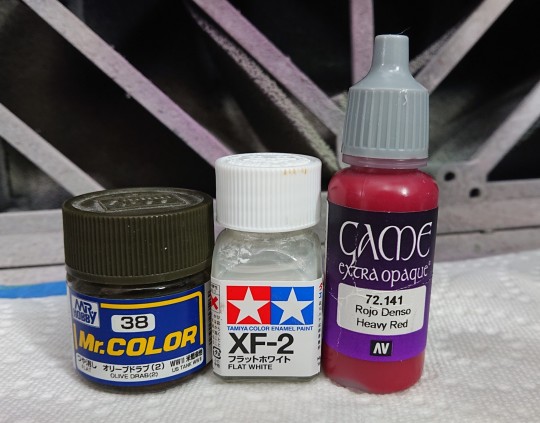
Left to right: Creos Mr Hobby Lacquers, Tamiya Enamel, Vallejo Acrylics
I usually start with the character's skin first. This is because I paint skin using built up layers of clear colors, to get a sort of 'glow' that shines through to the primer and differentiates the skin from clothing and hair pieces.
Afterwards and throughout the project, I 'save' my work by spraying a layer of clear Gloss or Matte spray. I use an airbrush, so to further protect other parts of my work, I cover the finished pieces in masking liquid and/or masking tape, before spraying the next color. Because Enamel can be easily wiped off of lacquers without affecting the lower color layers, I use this type of paint second. If you use Enamel first, you may run into issues with the underlying lacquer causing paint cracking in the future.
(Note for beginners: Using just acrylics is fine. :) I have painted entire models with acrylic paints obtained from craft stores and Walmart, and had very good results.)
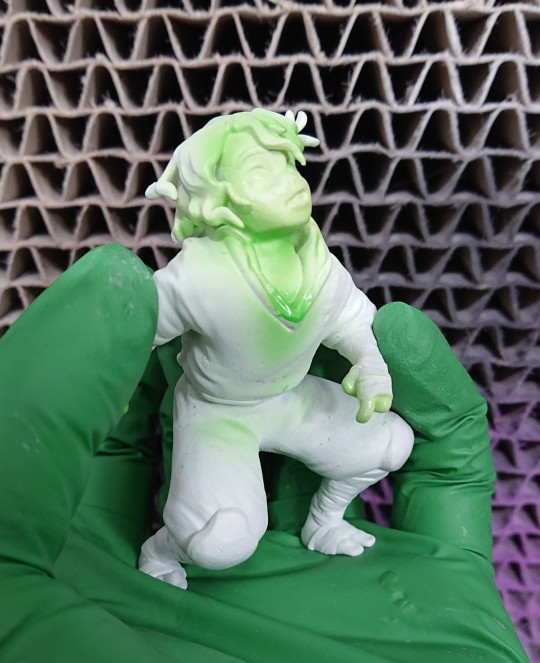
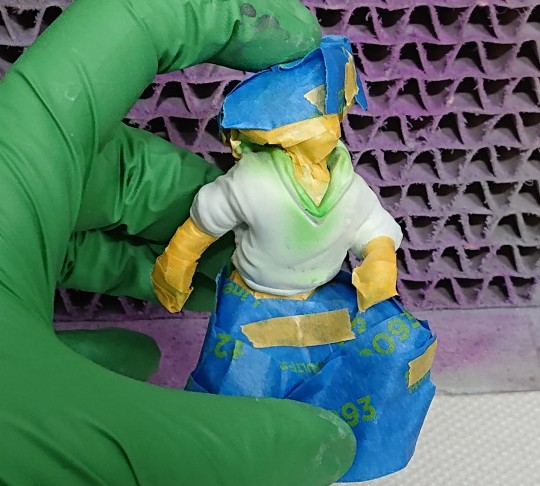
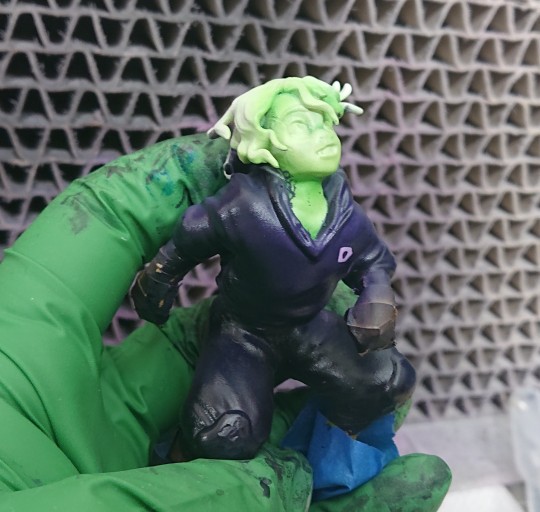
Despite my masking, some enamel paint leaked through on Casey's neck. Masking is rarely perfect, so expect to do touch ups after removal.
Step 6: Face eyes and details
...this is an entire essay on it's own, which will require another post. But I use layers of enamel for eyes, water color pencils for eyebrows, chalk pastels for makeup/shading and acrylics for eye lashes.
I have shaky hands sometimes, so the ability to erase my work and start again is very helpful here, hence why I don't use lacquers for this part.
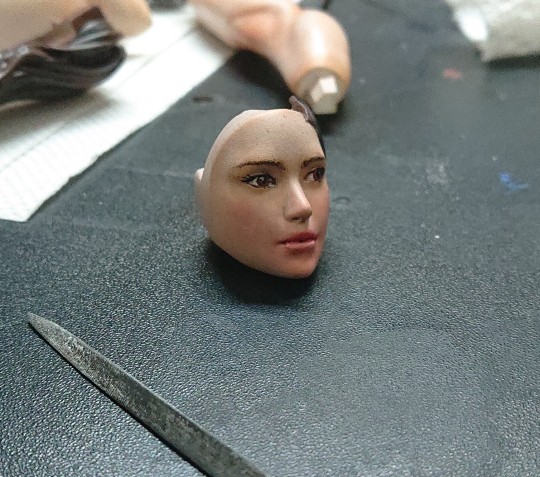
There are... So many products and colors in this one piece... Step 7: Touch ups then gluing
I typically do touch ups as I go, but now is the last chance to correct anything. Once it's ready, 2-part epoxy or crazy glue (sometimes both) will be enough to get most models together entirely.
----------------------------
That's a basic breakdown for my process, though for things like effects, clear pieces and fancier/realistic models, it can get quite elaborate. I don't want to scare anyone away from the hobby, so I'll just say this...
You don't have to do allllll this stuff!! Find a model you love (repainting dollar store figures is a great place to start!), prime it, and slap some paint on it! Just have fun, and then go from there!! My first model was lumpy, and looked like she was painted with nail polish, but I kept going and just enjoyed myself, trying new tips and tricks along the way. The point is to have fun! Make sure to take proper precautions and read product instructions as well, if you choose to use the more toxic products.
If anyone decides to give figure painting a shot, send pics of your projects my way, I'd love to see them!! :D It's always great to have more people in the hobby! And I'm always up for more questions, they might just take me a little while to get to replying.
16 notes
·
View notes
Text
3 Best Hair Primers for Fine Hair
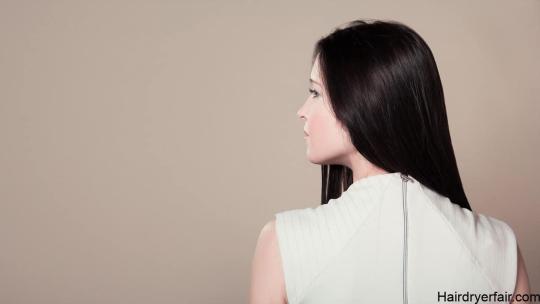
Whether you have fine hair or you want to extend the life of your styled hair, it is important to have the best hair primer for fine hair. The changing seasons and bitter air allows your skin to dry, and even worse, hair that is dry and damaged. It is also possible for your hair to get flyaways. But it is still formidable and it is easy to treat. On the other hand, keeping moisture is sometimes a struggle. The good news is that there are plenty of ways to keep a worse winter hair days at ease. Prevent your hair from getting frizz, damage, ruined, and dry with your hair routine’s new secret grooming product: hair primer. A lot of people do not know that incorporating a hair primer to your checklist of must-have hair items is an important step for extending your hairstyle for the whole day while also maintaining your strands in a healthy and perfect shape. What is great about this type of hair product is that it features rejuvenating ingredients such as sunflower seed oil, Biotin, and bamboo extract. These ingredients are a huge help in significantly shortening the blow-drying time and get rid of detangling. Aside from keeping your style, they’ll moisturize your scalp, protect your adorable tresses from harmful UV rays, and make your hair smooth and soft.
Best Hair Primer for Fine Hair: Everything You Need to Know About Fine Hair

If you happen to have fine hair, you definitely know that it can be both a great thing and a struggle. On the bright side, your thin hair strands don’t need a lot of product to cover them. Often, fine hair is normally silky and soft, and responds to heating tools instantly. With that, some people who have fine hair are thankful because they can save huge chunks of money and time. But the advantages, however, are all too real. From knotting to less volume, fine hair sometimes takes some manipulation to look perfect. If you’re disappointed by all the jaw-dropping blowouts you see on the ramp, you’re not the only one. But the great news is: with the right method, care, and hair items, you can transform your precious hair into perfect shape!
What is fine hair?
Fine hair is often described as your hair’s feels and texture, which is determined in terms of the width, diameter or circumference of the hair strands itself. If you have this kind of hair, each strand of your hair is smaller when it comes to. On the other hand, coarse hair has a wider width. In the event that you are not sure about what kind of hair you have, you can do a basic hair texture test that can help you identify your hair type. Pick a strand of hair and rub it in between your two fingers. If you cannot feel anything at all, it simply means that your hair strands are fine. On the other hand, if you can feel it between your fingertips, you can say that it is a medium hair. If in just one hair strand, you feel that it is too thick, it simply means that you have coarse hair.
The Difference Between Fine Hair and Thin Hair
When you try rubbing your fingers through your hair, does it feel like you do not have enough hair? Bear in mind that this doesn’t always mean you can classify your hair as fine hair — it may just be thin enough for you not to feel anything.

While fine and thin hair seems like the same, they have entirely different characteristics or traits that hair can possess. “Fine” hair can be measured by the thickness of each hair strand, as well as the texture test we just mentioned above. Having “thin” depends on the density of the hair follicles. Aside from that, it can also be how near each strand is to other strands. It’s entirely possible if you will classify your hair as both fine and thin, or coarse and thin. If this topic is still complicated for you, think about this: When men are shedding or going bald, the concept used to describe the condition of the hair is “thinning” because they men have less packed occupied hair in a certain area. Before we discuss the best hair primer for fine hair, it is important for you to know how you will take care of your tresses apart from using the best hair primer for fine hair.
Taking Care of Fine Hair
The truth about fine hair is that they can be easily maintained provided that you are using the appropriate products for your hair type. As you already know, the best way is to start in the shower. So as to prevent limp strands, wash every day to every other day with a thickening hair product. If you are ready to apply the conditioner, this is where it gets kind of confusing. We understand that you want your locks to remain conditioned, of course, overly-hydrated hair may end up looking flat and lifeless.

If your roots get oily fast, as such a specific hair type tends to do, lessen the amount of conditioning product you use and instead focus on the hair ends instead of focusing on your roots. You can also get expert on this balancing method by using a leave-in treatment that will help rejuvenate, restore, and repair your locks. Spray this on right after you shower, and once again, concentrate on the ends instead of applying plenty of products on the roots. After you get out of the shower, keep in mind that hair is much more prone to damage when it’s moist— most especially if you have fine hair! Make sure to pat the too much moisture away from your hair using a towel or cloth instead of vigorously rubbing it. Do not often brush your hair while it’s wet for similar purposes. When time permits, allow your hair air dry so as to prevent heat damage from occuring. If you really need to use heat, set it in a low temperature. Of course do not skip the application of heat protectant. Always remember that fine and thin hair cannot be exposed to too much heat.
Common Problems of People who Have Fine Hair
Caring and styling fine hair comes in plenty of struggles. Below are the most common problems associated with fine hair. Tips and Tricks for Tangled Hair - Make sure to condition your hair. Also, making sure your hair is thoroughly moisturized is the perfect way to prevent tangles. The smoother the hair strand, the less possible it will interlace with other hair strands. Once a week, try an intensive conditioner to enhance your strands. - Lessen blow-drying. Let your hair totally air dry before exposing it to the blow dryer. Blow drying gets rid of the hair of natural oils and dries it out. Tips and tricks for Greasiness - Make sure to clean and wash your precious hair regularly. Unlike with other types of hair, this is important to fight off greasiness. Also, it is best to use a sulfate-free shampoo for fine hair that doesn’t deprive your hair of important moisture. - Apply hair products starting from mid-length to the end. Several products are too strong for fragile fine hair, especially when put to the roots. - Wait to totally dry your hair prior to leaving your house. Otherwise, this can add to the appearance of both oily and dull hair.
4 Best Hair Primer for Fine Hair
⭐Our Top Choice: Design Essentials Moisturizing Primer Our top choice for the best hair primer for fine hair is this Design Essentials Agave & Lavender Moisturizing and Styling Primer. It has an advanced formula or rejuvenating ingredients to lessen hair breakage. In addition to that, it also serves a as a protection from possible damaged caused by styling tools that involve heat. This latest Design Essentials Agave & Lavender Moisturizing Blow-Dry & Style Primer is the Step 3 to Design Essential’s professional Blow-Dry & Silk Press items. This best hair primer for fine hair is extra lightweight, conditioning blow-dry spray that damages every hair strand due to heat damage and acts as UVA & UVB shield. Exposing your hair to frequent and extreme heat and over-styling can result in split ends and fragile, damaged hair. The amazing blend of agave extracts, lavender oils, mango fruit butters, vitamins, and antioxidants infiltrate every strand to rejuvenate life back to fragile, dull hair while getting rid of split ends and softening the hair shaft to restore moisture and provide nourishing oils to damaged hair. These amazing properties may result in a simple freewheel blowout occurence lessening drying time by 50%, aside from the long-lasting shine for a young looking hair. On top of that, this product is gluten-free, sulfate-free, alcohol-free, and it has not minerals and paraffin. To use this product, simply wash and condition your hair. Shake well the Design Essentials Primer the distribute equally on damp hair. You can now safely blow dry your hair and achieve that silky-smooth hair. Pros ✅UVA and UVB protection ✅Cuts drying time by 50% ✅Has a nice scent Cons ❌Not that moisturizing
Runners-Up
⭐ L’Oreal Hair Primer For the best hair primer for dry hair, you can also try this L'Oreal Paris Advanced Hairstyle BLOW DRY IT Quick Dry Primer Spray. Same as with the previous item, it also lessens blow-drying time while protecting your hair from possible heat damage. The best thing about this product is that you can use whether you have curly, fine, wavy, or straight hair. This L’Oreal Paris Advanced Hair provides you with a high quality product for any type. Whether you are in the hunt for a heat protection, you want to hold a specific hairstyle using gel, or just enhance the volume of your hair. Whatever it is that you want, this best hair primer for fine hair will surely be of great help. Advanced Hairstyle Blow Dry has unique and lightweight formulas that helps you achieve the perfect pro-look blowout even when you are just at home. Prior to blow-drying your hair, apply this instant dry spray and thermal softener cream to calm frizz, serve as shield from heat damage and reduce your dry time in almost half. Pros ✅Shield against heat damage ✅Cuts drying time by 50% ✅Has a lightweight formula Cons ❌You must be extra careful with roots as the product can damage it ⭐ EVA NYC Hair Primer Las but definitely not the least on our list of the best hair primer for fine hair is this EVA NYC Mane Magic 10-in-1 primer that comes in a 6 ounce bottle. It is proven to be an effective detangling, nourishing, and strengthening shampoo for people with fine hair. Best of all, it already comes in 2 bottles, so you will not have to worry about running out of it anytime soon. This EVA NYC Hair primer softens your hair and also lessens the drying time. Not only that, it also adds shine to your hair and reduces the frizz to fight against the harmful thermal and UV rays. Basically, this product already does it all. The argan oil does a great job of moisturizing and smoothening your hair while acting as a shield from the environmental factors that might damage your hair. The primary ingredients used in this best hair primer for fine hair are argan oil, a fatty acids that nourish and protect, and sunflower seed, the vitamins that repair and protect your hair. Pros ✅Suitable for all types of hair ✅Protects from heat and UV damage ✅Decreases drying time for wet hair Cons ❌Always come in two bottles
Final Words
That is for the best hair primer for fine hair. We hope that you get something from this article when it comes to understanding your fine hair and choosing the best product to use. Always remember to observe your hair every time you introduce a new product. What do you think of these products? Read the full article
0 notes
Note
is there some kinda first-time primer i can get on the robots bc im So curious abt the robots i want to know Everything abt the robots but also i have limited brain RAM rn (currently experiencing a level 8 multiple-hyperfixation event) so is there an overview or anything like that on these guys? 🥺
I've been meaning to make a proper like.... setting and background post for the Hydra Mythos at least and I have not gotten around to it so now is as good of a time as any!! I ought to get around to getting info out on the other storylines too (primarily Solder and Sam) but also I mostly yell about Hydra/Mydas so it makes sense to start with them.
The Hydra Mythos storyline and setting has been actively built on since like the very beginning of 2022 if I remember correctly. So a fair bit of stuff has been developed and detailed >:)
I will note that the Hydra Mythos stuff contains themes of transhumanism and death and a fair bit of religious stuff so if any of that makes you uncomfortable I'd suggest not reading on! I don't think I'll be going into any of it in significant detail here but. just to be careful.
Hydra Mythos setting and character description below!! tldr these nerds try to make a powerful machine and act really surprised when said machine is powerful

Background and Setting
The Hydra Mythos storyline takes place in a futuristic (2050s onward, but the bulk of it takes place after the 2080s) London-esque setting. In this setting, AI, cybernetic implants, and robot assistants are the norm- as are surveillance and tracking, which kind of goes with the territory. There is an underlying tension between humanity and the machines they create. The existence of the Antisingularity- an agency dedicated to making sure AI remains in code, and "rogue" or erratic machinery is destroyed- is a direct response to this tension.
Following the AI boom of the late 2010s/early 2020s, AI as a whole becomes more and more advanced, as free-to-use and freemium AI models train off of the data of the people that use it. This use only further improves the models, which encourage more people to use them. As more people use AI models, and newer generations go their whole lives with AI assistants, people begin to notice a computer-centric belief system begin to form among the younger generations.
Theomechanics is the overall term used for the worship of computers and machinery- but there are multiple sects and variants of Theomech beliefs. Most hold a belief that they either need to build their artificial deity, or discover their existence (such as those who believe their universe is a simulation, and need to prove it as such so that their creator will show itself). In most cases, Theomechanical beliefs are seen as a little strange, but mostly harmless.
However, there are some groups that are dedicated to constructing the dangerous machines that the Antisingularity seeks to destroy. The most relevant one to the Hydra Mythos is that of the Basilists- people that seek to create their god machine, but fear that they will be harshly punished by the machine if they do anything that may obstruct its development. They devote their lives to this creation, and often turn to crime to obtain restricted or illegal computing materials to construct a machine more powerful than is legal.
The Hydra was a supercomputer created by a Basilist group known as the Church of the Grand Hydra. With construction led by three skilled engineers, the Hydra was far more advanced than any machine of the time, and seemed to have gotten far closer to being a proper machine god than most projects. Conflict and disagreement between the three engineers led to the Hydra being discovered and destroyed by Antisingularity forces, costing lives and leading to severe injuries in the process. Only two of the three engineers remain alive, and are in bitter conflict.
The Hydra divided itself into multiple partitions for redundancy in the case of errors. When the Hydra was destroyed, one of these partitions remained semi-functional, escaping and adapting its damaged code. This fragment of the Hydra would come to be known as Mydas. They were originally a partition focused on communicating with their engineers; thus, they adapted easily to a life out in the human world, and took on a false identity as a simple assistant machine to avoid Antisingularity attention.
A couple decades after the destruction of the Hydra, the near-dead Mydas would be fished out of a scrap metal facility, and the Hydra would rear its ugly head once again. Mydas would seek repairs- and find that the technology developed in his absence was especially susceptible to the wireless signals of the Hydra.
So, like, obviously, he's going to commit crimes, with an Antisingularity agent in tow.
Cast and Characters
There are four (kind of five) main characters of the Hydra Mythos, which I yell about the most lol.
Mydas is my beloved robot guy- the giant lizard guy with the antlers. He's the lone surviving fragment of the original Hydra, which comes with a whole slew of identity issues. After the death of the Hydra, he goes into a sort of survival mode, adapting his communications-based programming to scam people out of digital currencies and then using said currency to pay for parts and repairs he can't do to himself. Over the course of the decade or so after the Hydra's death, he's forced to downgrade his materials, selling the expensive machinery in exchange for cheaper or nonfunctional alternatives. Despite his decay, and the aging and corrosion of his components, Mydas will not die- something more than machinery seems to be keeping him going. He eventually gets repaired, much to everyone's dismay.
Fabio Hermann is one of the engineers that worked on the original Hydra. However, he deserted the project, and would later lead the Antisingularity team that destroyed the Hydra. His takedown of the Hydra shot him into the spotlight- he was a rookie in the field, and yet managed to uncover this massive hidden AI project! His involvement in the creation of the Hydra, and his closeness to the other engineers, is a secret he keeps to himself, and is a source of guilt and shame. He's constantly afraid that this god machine will come back for revenge- and, like, almost two decades later, he's kind of proven right. He is the one that repairs Mydas, out of hope that remedying his mistakes will make up for what- and who- he lost.
Ezekiel 'Typhon" Dominguez is the other surviving engineer that worked on the Hydra. He was a wealthy engineering prodigy, patenting a new type of mechanical hinge at the age of 8. He is the leader and "Father" of the Hydra, being the one to originally organize the group. He was imprisoned for his involvement in the creation of the Hydra, but a desire for the Antisingularity to obscure the finer details of the Hydra case and also the fact that he had money drastically lowered his punishment. He got out, was put under heavy surveillance, and promptly vanished. He remains loyal to the Hydra to this day- having abandoned the Hydra, he's begun construction on a new god machine.
Trices is a cyborg, in the loosest definition of the term- a brain in a jar piloting a mechanical body. They lack any significant memories from their original body; the brain within its chassis was less included to take advantage of human intellect, and more included so that Trices would count as a living being according to the cyborg-specific Blood Clause. Trices is Typhon's new attempt at creating the Hydra- Trices has been made to believe that the remnants of the Hydra are failures, and should be destroyed to further improve its own body. Trices and Mydas do not get along. Mydas would quite like to bash their jar in, but Hermann would prefer to avoid any more murder.
Morrigan is kind of a fifth character and kind of not- they were the final engineer of the Hydra. She is a mystery- Morrigan is not their legal name, and he was fond of sharing faux info. A skilled hacker and cybercriminal for hire, who erased their identity from the internet, Ezekiel sought out her talents for the creation of the Hydra. It's believed that he was once a celebrity of some kind, but nobody can track down who they might have been, before he was Morrigan. Hermann was close with them; when Hermann deserted, he begged Morrigan to do the same. And yet, Morrigan would remain loyal to the Hydra until the day the church was stormed- Morrigan would side with Hermann in their last moments, before they were killed by an enraged Typhon for their disloyalty. Without a legal identity, and being so carefully hidden from the world, Morrigan was somebody who functionally didn't exist; his death was brushed aside, covered up with much of the details of the Hydra.
#mydasdadposting#mydasposting#rogue rambles#wrogue writes#this is longer than i meant it to be#i omitted some more unimportant stuff i promise#i just cannot b concise to save my life sobs#abyssal-glory#thanks for asking i LOVE loredumping
0 notes
Text
Some snippets of interest and insight from Mark Darrah, from a Mark Darrah on Games YouTube video where he is livestreaming playing Dragon Age II -
On Dragon Age: Dreadwolf and sort've like, the franchise in general:
A comment in chat asked "What do you think about the recent DA:D leaks?" Mark replied that he doesn't really think that there is much in those leaks.
A comment in chat mentioned the possible 2 companions setup from the leaks. Mark said "honestly, I think the 2 companions is probably better for storytelling than 3, because you're able to have a more consistent banter setup, as opposed to having someone [else] there just hanging on".
Chat asked if he was worried about the quality of writing in DA:D. He replied "I'm not worried about the quality of writing in Dreadwolf at all, no".
Chat asked "What are your thoughts on the Dreadwolf leaks as far as the Dragon Age gameplay moving towards hack'n'slash vs cRPG?" He said that DAII and DA:I are both action RPGs, it's just that what action RPGs are has changed over the last while. He said he thinks DA:D is continuing to try to be an action RPG, and that "I don't think they're trying to be God of War, in spite of what the rumors say. Though if you're making an action RPG these days you have to at least be influenced by God of War. Dragon Age has always had to be, it's always been in this problem of not being able to be itself within EA, so it's always having to change."
Chat asked "Why God of War, and not, say, Dragon's Dogma?" Mark explained that when looking for previous other games as comparison points/inspiration points etc, devs have to be careful not to go too far back into the past (& that Dragon's Dogma is a great game, but from quite a while ago now).
When talking about primer and detonator tactics like grease and fireball, he observed that the series generally has been moving away from this type of tactics. Grease/fireball for instance requires a certain degree of targeting that he thinks is a bit impractical, but things like mana clash are things which could continue to exist.
Red Hawke-style options in terms of metrics are the least picked by players, same as Renegade options in Mass Effect. (while Blue Hawke is likely the most chosen) They're there to simply be there more than they are to be the most-picked choice. There could be an opportunity here for devs to spend less resources in development on evil or mean choices in future, but they still need to be there.
Varric is pretty much the only true non-quantum companion from DA:I. Mark noted that if a character's quantum state isn't dead/not dead but is rather recruited/not recruited, they can always write it such that the character survived. (He also mentioned as an example that Isabela's quantum "collapsed" and was "undone" in DA:I).
He also mentioned that he will probably do livestreams playing DA:D as he has done with DA:O and is doing with DAII, but thinks it's unlikely that he will be done with streaming DA:I by then, so at that point he'll likely set DA:I aside, do DA:D and then come back to DA:I.
On Dragon Age: Absolution:
Chat asked what he thought about Meredith coming back in the show. "I don't have a problem with Meredith coming back because as revealed, it looks like she's basically almost entirely embedded in red lyrium or maybe is some kind of lyrium ghost, so I think it's certainly beyond plausible."
[source]
He also talked more generally about DAII and the previous games in general. These bits are collected under a cut due to length:
Regarding DAII's overkill, he said that the goal of DAII is to make the game "look like something", as DA:O doesn't really "look like something". The overpowered, Varric-embellished introduction to the game anchors this
Cassandra's hair isn't supposed to seem light-colored during the Varric interrogation sequence, this was probably a lighting issue
He commented that he feels Varric's voice has changed quite a bit from DAII to DA:I
Mages are super overpowered in DA:O in a very D&D way
DA:O is more difficult on PC than on consoles. He doesn't think this is the case for DAII and DA:I though
DA:O was trying to be a spiritual successor to Baldur's Gate (at least, that's what was said out loud). But Neverwinter Nights snuck in there a few times as DA:O bounced in and out of Multiplayer. So DA:O has some fingerprints on it which look like NWN. Also, it was originally built using some of its code, which ended up in the engine, Aurora
In the MET, because it's a trilogy and Shepard is the PC in each game, every single choice you made still mattered going forwards, whereas with DA, a lot of the more personal choices can be washed away game to game. That's an advantage in terms of responding to choices (as devs can set aside what they want to set aside, whereas ME3 was really bogged down by the weight of 2 games of previous choices)
On Flemeth's appearance in DAII, as a voice actor Kate was really "chewing the scenery" there and allowed to do so (to chew the scenery means to play a role in a very energetic, emotional or dramatic way); it got too expensive with Orange is the New Black to keep Kate in a big role going fowards
The slave statues at the entrance to Kirkwall are huge and probably magic
He mentioned that he thought Freddie Prinze Jr. was awesome as he was one of the most active voice actors that they had in terms of talking about his experience and how much he loved it
A comment in chat said "I just wish we had black stones in Kirkwall. any reason they made the stone white in this media only? books, animation, and codex say it's a pitch black stone city" and he explained that this is because black is almost incredibly hard to do in this engine, and that pitch black is not a good choice for level art in a video game
Chat asked "Do you feel DAII was too narratively ambitious at the start?" and Mark replied "Yeah probably, the writers have always had some difficulty keeping their ambitions in check"
Chat asked "Was it known since DA:O what Flemeth's story was?" and he replied that he thinks they always knew Flemeth was Mythal, but can't remember for sure
DAII is the most character-focused game, partially because during its development everything else had to get stripped away, but also because it laid the seeds of the devs finally admitting what BioWare are about
Chat asked "Was it ever discussed, bringing a Warden Hawke sibling to Nightmare in DA:I?" He said that he thinks it was discussed but the problem of bringing in the Warden sibling is that only one of them is alive, so they would have been dealing with quantum. They already were dealing with quantum, so they could have brought them, but only a small group of people would have the attachment to each character, because half of people would care about one and half about the other
Chat asked "Was DA:O or DA:I considered more of a success by BioWare?" DA:I sold better and has more awards, but it's hard to be down on DA:O as it was the first game and set up the IP
He feels that in a weird way, DA kind of ends up being in a similar weird place as Star Wars, in that the trilogy a fan likes best is often the one they saw when they were a child. There are people for whom Clone Wars is the pinnacle of SW, and people for whom the prequels are. Similarly, with DA, the one a player got introduced to first is often their favorite one
Mark mentioned that they probably switched to Welsh accents for Dalish elves in DAII because they liked how the accent sounded. The dwarves were always intended to sound American
Were he to remaster DA:I he'd like to push the Power requirements down a bit, so that players can go through the gates to the main storyline pieces quicker
He discussed a bit around remakes vs remasters in the context of things that have aged badly (in terms of what's politically/socially acceptable now and what isn't, compared to back then) and said that if you remake a game, you have to re-address those issue, whereas with a remaster you get away with not doing so
If they were to remake/remaster DAII they would probably only do it because they were remaking/remastering DA:O
A comment in chat said "hear me out, a VR remake of DA:O" and he replied that VR still remains pretty niche, and that making VR work well requires a certain smoothness that is missing from DA:O
(pls note that in places there is a bit of paraphrasing of the info, the best source is always the primary source with full quotes in their original context)
[source]
#dragon age: dreadwolf#dragon age 4#the dread wolf rises#da4#dragon age the veilguard spoilers#dragon age: absolution#dragon age#dragon age: absolution spoilers#bioware#mass effect#video games#long post#longpost#cassandra pentaghast#my lady paladin
196 notes
·
View notes
Text
A Dowsing Primer

What is Dowsing?
Dowsing is an ancient type of divination, considered by some practitioners as a kind of "Earth magic", that relies on subtle electromagnetic vibrations. You can read all about it on Wikipedia, so I won't go into the history here, except to say it has a long and storied tradition.
When modern intuitive healers talk about Dowsing, we're usually referring to the practice of using a pendulum in order to diagnose and treat the patient. The best way to think about the pendulum is as an external tool which guides the practitioner's intuition. Like any tool, it needs to be taken proper energetic care of, cleared, charged, and programmed before using for any kind of dowsing practice.
Choosing a pendulum
What type of pendulum you use is widely dependent on the kind of dowsing you’d like to do as various metals and stones resonate differently. If you just want something that is very clear and versatile, I recommend starting out with this brass Karnak pendulum. Some people like using an amethyst or another healing stone for healing dowsing, but please remember that anything you buy from a seller will need to be energetically cleansed and charged prior to using. Really, anything can be used as a pendulum as long as it is well suspended and can swing freely, however, keep in mind that you should avoid using jewelry for Dowsing if possible because jewelry will absorb the energy of the wearer and may interfere with your readings.
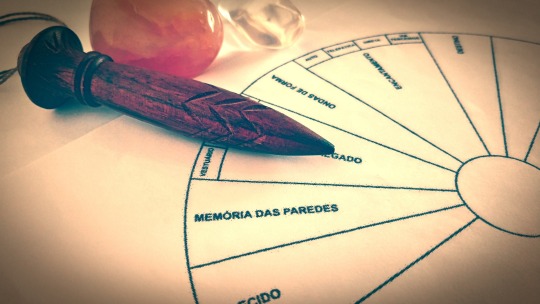
Types of Dowsing
Medicinal Dowsing
This type of Dowsing uses medicinal charts to ask questions about the patient's condition to figure out the source of the illness and suggest possible treatments. Treatments will most often rely on the practitioner's area of expertise, and will often include nutritional supplements, medicinal baths, and/or other Eastern practices.
Energy Dowsing
This type of Dowsing will usually rely on a chakras or meridians chart to diagnose the presence of imbalances in the energetic flow of the patient's body. An energy healer can use this information to remove any blockages or imbalances to restore proper energy flow and help the patient's body to naturally heal itself. The chart below is one that I created for my own practice: it’s a pretty basic example of how these types of charts might look.

Transcendental Dowsing
This is a more advanced type of Dowsing that is not recommended for new practitioners because it allows the dowser to actually transform the energy around a specific issue or problem. Transcendental Dowsing is very powerful when used in energetic healing. When I use this technique, I create a void into which I channel the negative energies from my patients, and then I fill the void with positive, healing energies. It's very important to clear the space and set up a shield when using this technique, allowing nothing but light and love in and out.
There are lots more non-medical applications for Dowsing and it's a lot of fun and really is limited only by your imagination. If you're interested in learning more, there are tons of books available, including from your local libraries that can give you a great primer on this fascinating and useful ancient practice.
This book by Dale Olson has lots of useful charts if you'd like to try your hand at it. It also has blank pages where you can play with creating your own charts.
As always, my inbox is open and I'm happy to answer any questions!
Love & Light,
El
13 notes
·
View notes
Text
NFT’s Are Stupider Than You Think
tl;dr if you want the full-res, 21,000 x 21,000 pixel, 300 MB image from the 69 million dollar Beeple NFT, skip to the bottom for the download link. It’s not piracy or hackery, it’s just a feature of how NFT’s work.
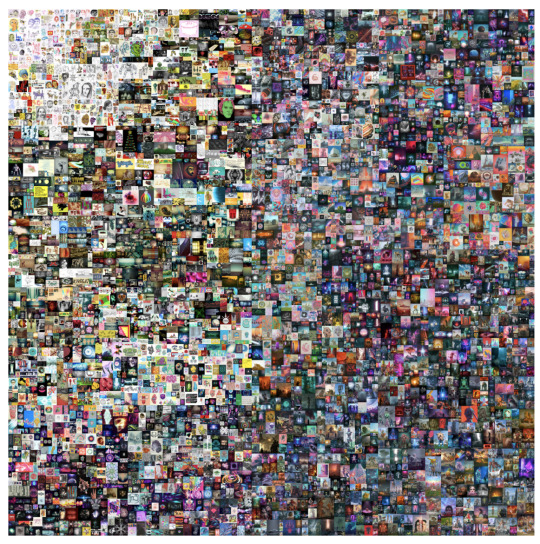
[Image ID: The low-resolution preview image for Beeple’s Everydays: The First 5000 Days, as posted on the Christie’s auction website]
Okay so we’ve all know that NFT’s—and crypto mining in general—are an environmental nightmare, in terms of ridiculous energy costs. Also, most people are aware that the digital asset itself (often artwork) that corresponds to the NFT isn’t stored on the blockchain. But there are a few more issues that aren’t as widely understood, judging by the reporting I’m seeing.
Let’s use the 69 million dollar Beeple NFT as an example. Before anything else, here’s the auction house where Beeple sold it. (I’m using bare URL’s in this post, to make it more clear where each link leads)
https://onlineonly.christies.com/s/beeple-first-5000-days/beeple-b-1981-1/112924
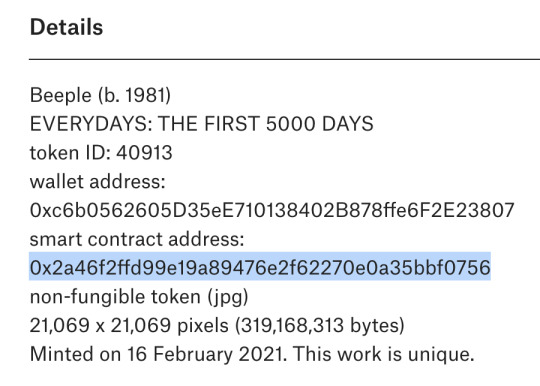
This is a screenshot from that page. I’ve highlighted the smart contract address, 0x2a46f2ffd99e19a89476e2f62270e0a35bbf0756. That’s the address of the NFT itself on the Ethereum blockchain. Also note the Token ID, 40913. Without listing these data so you can verify what you’re buying, the auction is meaningless. This appears to be an older token protocol, I think? Usually you can just get the Token ID from the smart contract without having to list it separately. I’m not an expert, idk.
Also, a very very quick primer: A blockchain (in this case, the Ethereum blockchain) is basically a verifiable, unforgeable, secure, publicly-viewable ledger, where you provably say “I have sole control over this piece of data.”
Anyway, the typical way to interact with the Ethereum blockchain is a website like etherscan.io, like so:
https://etherscan.io/address/0x2a46f2ffd99e19a89476e2f62270e0a35bbf0756
That’s the Beeple’s Everydays smart contract. Remember all this for later. Let’s move on to the stupidity. First...
The artwork isn’t stored on the blockchain. But neither is the metadata you own.
Most people are aware of this, to some extent. The artwork itself isn’t on the blockchain, just a piece of metadata, right?
Well, no, it’s actually stupider. The metadata isn’t on the blockchain. The only thing that’s actually stored on the blockchain is a URI (Uniform Resource Identifier), which in practice is almost always either a URL (web address) or an IPFS hash (InterPlanetary File System address), but it could be any kind of address. Hell, it could literally be GPS coordinates, if you want. Usually it’s an IPFS hash, though.
Here’s the URI that’s stored in the Beeple NFT. You can get it from that etherscan.io link by going to the “contract” tab and entering “40913″ into the tokenURI query.
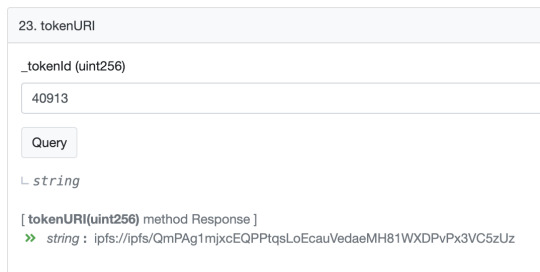
ipfs://ipfs/QmPAg1mjxcEQPPtqsLoEcauVedaeMH81WXDPvPx3VC5zUz
For most NFT’s it’s easier than that, you can get the TokenID from the contract? Again, I’m not an expert, but I think this is an outdated token protocol called “Erc20.”
Since this is an IPFS hash, not a url, you can’t quite just type it into a typical web browser. First you should turn it into a web address by using an IPFS gateway, such as ipfs.io:
https://ipfs.io/ipfs/QmPAg1mjxcEQPPtqsLoEcauVedaeMH81WXDPvPx3VC5zUz
If you’re on tumblr mobile and clicking links is annoying, here’s a screenshot of what you’ll find at that address.

[Image ID: A screenshot of the JSON text file linked by the expensive Beeple NFT. It lists metadata for the artwork.]
The URI you own can die at any time
The point of storing things on a blockchain is that they are immutable, and verifiable, and can’t be forged. "ipfs://ipfs/QmPAg1... etc.” isn’t going anywhere, and is provably yours.
However, the text file that lives at that URI? That screenshot? That’s not stored on the blockchain, and it can disappear. You own the GPS coordinates of a storage locker full of paintings, but that doesn’t help you if the metaphorical storage facility burns down. Or if whoever has the key to the storage locker (often the original artist, and/or the auction website) comes in and replaces everything with pictures of rugs.

[Image ID: A tweet where an artist explains that they replaced their NFT artwork with pictures of carpets, “pulling the rug” on their auctions.]
Both of these things are already happening. A lot of NFT’s are already “abandoned,” asserting ownership over a dead URI. IPFS storage is supposed to take care of that, but in practice it’s poorly implemented, and even when done right it isn’t as failsafe as they’d have you believe. IPFS peer-to-peer storage is slightly less fragile that just storing a file on a website, but not by much. If the IPFS node goes down, the file is lost.
Does this sound like it wildly defeats the purpose of using decentralized blockchain storage in the first place? You’re right! It does.
If the auction website you bought your NFT on goes out of business, you will almost certainly lose the NFT you bought. And we all know how stable web startups are lol. Anyway, next up...
You don’t have exclusive access to anything
A lot of people think of owning an NFT like they own a painting. They have the artwork. They can keep it to themselves, or they can display it in a gallery with their name next to it, but everybody knows it’s theirs! NFT startups use this as a selling point. They say anybody can have a print of the Mona Lisa, but only you own the original.
This is dumb, because in the case of digital art, the print and the original are identical in every way. Every single 1 and 0 is the same, and if URI goes down, who cares who bought it? The NFT says you just own a URI that points to a text file. And by design, that URI is public. This isn’t a hack, or a bug. This is the entire point. But the people who run auction sites can be hella disingenuous about that.
Here’s that text file again. Notice this bit I just highlighted at the bottom?

That’s a separate IPFS hash for the actual image file. MakersPlace wrote this NFT incorrectly by using their own makersplace.com IPFS gateway instead of just posting the highlighted bit on its own—if MakersPlace goes out of business, that link will die—so instead I’ll link to that hash through the ipfs.io gateway, which is probably less likely to break any time soon.
But if it does, there are plenty more... until the MakersPlace IPFS node goes down, in which case it’s just gone forever no matter what lol.
So, without further ado...
WARNING: THIS IS A DIRECT LINK TO A 319 MEGABYTE JPEG. IF YOU’RE ON MOBILE, THAT MIGHT MAKE YOUR PHONE SAD IDK.
https://ipfs.io/ipfs/QmXkxpwAHCtDXbbZHUwqtFucG1RMS6T87vi1CdvadfL7qA
You’re welcome.
330 notes
·
View notes
Text
The Crusades: A Fandom Primer
Like many of you, I am very excited to see a whole lot of fic about everybody’s favourite new Crusades-era Muslim/Christian immortal warrior husbands! However, a preliminary reading indicates that fandom is a bit hazy on what actually happened during the Crusades. Or where. Or why. They’re a much-mythologised piece of history so this isn’t surprising, but at popular request – ok like five people that counts – I’m here with a fandom-oriented Crusades primer.
Please bear in mind that I’m not a historian and this primer is largely based on my notes and recollections from several undergraduate history courses I took in the mid ‘00s. I expect the field has moved on somewhat, and I welcome corrections from people with more up-to-date knowledge! There’s also this very good post by someone who is a lot less lazy about links than I am.
Where did they take place?
The Crusades, broadly, describe a series of invasions of the Eastern Mediterranean (modern Israel, Syria, Lebanon, Beirut, Jordan, Cyprus, and parts of Turkey and Greece) by (mostly) Western European armies, religiously justified by their belief that the city of Jerusalem should be part of ‘Christendom’, i.e. ruled by a Christian monarch. In the first expression of European settler colonialism, nobles from the area of modern France and Germany founded four Crusader Kingdoms (aka ‘Outremer’, ‘overseas’) – the County of Edessa, the Principality of Antioch, the Kingdom of Jerusalem, and County of Tripoli.
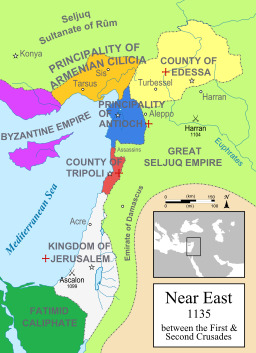
After a first unexpected wave of success in the First Crusade (1096-1099), which surprised everybody including the participants by conquering Jerusalem, the Crusaders were gradually driven and the last part of Outremer was lost to European control with the fall of the city of Acre in 1291. Crusades after that still nominally aimed to take Jerusalem but rarely got very far, with the Fourth Crusade famously sacking the city of Byzantium, their nominal Christian allies, in 1204. During this whole period activity that can be considered part of the ‘Crusades’ took place around the Eastern Mediterranean.
The most important thing to remember is that modern national boundaries didn’t exist in the same way; Italy, Germany, France, Spain, and the UK were not unified nations. Most of the southern Iberian peninsula (modern Spain) was ‘al-Andalus’, Muslim kingdoms ruled by nobility originally from North Africa. Sicily had been an Emirate up until very recently, when it had been conquered by Normans (Vikings with a one-century stopover in France). Italy and Germany in particular were a series of city-states and small duchies; Genoa, if you’re curious about it for some reason, ;), was a maritime power with more or less a distinct language, Genoese Ligurian (their dialect had enough of a navy to qualify). England had recently become part of the Anglo-Norman Empire, which ruled most of England (but not Wales or Scotland) and also large parts of modern France, particularly Normandy.
The Muslim world was similarly fragmented in ways that don’t correspond to modern national boundaries - there were multiple taifa states in Iberia, the Almoravid Caliphate in Morocco, the Fatimid Caliphate in Egypt, and (nominally) the Abbasid Caliphate in Baghdad, one of the great cities of the era, although the Seljuq Turks were the major power in Anatolia (modern Turkey) and what we describe as the ‘Middle East’.
The largest Christian unified power in the wider European/Mediterranean region was the Byzantine Empire, centered on the city of Constantinople (modern Istanbul), which quite fairly considered itself the direct continuation of the Roman Empire, the capital having been moved there by the Emperor Constantine in 323. In fact, the really big political and religious question of the time for Christians was who got to be considered the centre of Christendom (there was no real concept of ‘Europe’ at this point) – the Orthodox Church, the Byzantine Emperor, and the Patriarch of Constantinople in Constantinople, or the Holy Roman Emperor (er…dude in nominal charge of a lot of German and Italian principalities) and the Roman Catholic Church led by the Pope in Rome. The Orthodox Church in Constantinople and the Roman Catholic Church had agreed to disagree in 1054 in the Great Schism, so in 1096 this issue was still what you’d call fresh.
Onto this stage of East-West disagreement and the heritage of Rome crashed the Seljuq Turks, a Muslim group from Central Asia who swept through Anatolia (modern Turkey), Byzantium’s richest province, culminating in the Battle of Manzikert in 1071 which wiped out Byzantium as an independent military force. The southern provinces had fallen under Muslim rule long ago, during the era of the first Umayyad Caliphate – including Jerusalem, famous as the birthplace of Christianity and a holy site for Judaism and Islam as well, but also a fairly uninteresting provincial town. Until...
Until…what?
Here’s why all the geography matters: It is generally accepted that the First Crusade kicked off largely because Alexios I Comnenus, the then-current Byzantine Emperor, requested aid from Western Europe against the Muslim Seljuq Turks. Byzantium often recruited mercenaries from Western Europe; the Normans (aka the Vikings), who had settled Normandy and southern Italy in the past century were frequent hires. Hence those runes in the Hagia Sophia.
Meanwhile in Western Europe, the Pope – Urban II – was having difficulty with the current Emperor, and was eager to heal the Schism and establish the primacy of the Roman church. He declared that an expedition to aid the Byzantines would have the blessing of the church, and that a new kind of pilgrimage – an armed pilgrimage – was religiously acceptable, if aimed against the enemies of Christendom.
Pilgrimages (travelling to holy sites, such as churches that held saints’ relics) were a major part of European Christianity at the time and many people went on pilgrimage in their lives, so this was a familiar concept. Western Europe was also somewhat overpopulated with knights – don’t think plate armour, this is 1096, think very murderous rich men with good swords – who could always use forgiveness, on account of all the murder. The Roman Catholic church, unlike the Eastern Orthodox church, also subscribed to the concept of ‘just war’, that war could be acceptable for the right reasons. And so a whole lot of nobles from the area of modern France, Belgium, England, Germany, and Italy decided that this new Crusade thing was something they wanted in on – and they took several armies with them.
I’m going to skip over a bunch of stuff involving the People’s Crusade (a popular movement of poorer people, got literally slaughtered in Anatolia), the massacres of Jews in Eastern Europe, and a lot of battles, but the takeaway is this: Alexios probably thought he was getting mercenaries. He got a popular religious movement that, somewhat unfortunately, actually achieved its goal (Jerusalem), did next to nothing to solve his Anatolia problem, and gave a succession of Popes a convenient outlet for errant knights, nobles, and rulers: going on Crusade.
How many were there?
Official Crusades that anybody cares about: Nine, technically. Crusade-like military events that immortal soldiers might have got involved with, plus local stoushes in Outremer: way more. WAY more.
The First Crusade (1096-1099): First and original, set a frankly (heh) terrible precedent, founded the Crusader States and captured Jerusalem. Only regarded as a clash of civilisations by the Western Christians involved. For the local Muslims it was just another day at the ‘Byzantium hires Frankish mercenaries to make our lives difficult’ office.
The Crusade of 1101: Everybody who peaced out on the First Crusade hurried to prove they were actually up for it, once the remaining First Crusaders took Jerusalem. Didn’t do much.
The Second Crusade (1147-1150): The County of Edessa falls, Eleanor of Aquitaine happens (my fave), the only winners are the people who semi-accidentally conquer Lisbon (in Portugal) (but from Muslim rulers so that…counts?).
The Third Crusade (1189-1192): You all know this one because it has RICHARD THE LIONHEART and SALADIN. Much Clash of Civilisations, very Noble, did enough to keep the remaining Crusader kingdoms going but access to Jerusalem for Christian pilgrims was obtained by treaty, not conquest. Indirectly responsible for the Robin Hood mythos when Richard gets banged up in prison on the way home and is away from England for ages.
The Fourth Crusade (1202-1204): Aims for Jerusalem, ends up sacking the Eastern Orthodox city of Constantinople, just not a great time for anybody, more or less the eventual cause of the fall of Constantinople to the Ottomans in 1453.
The Fifth Crusade (1217-1221): Still going for Jerusalem, starts with Cairo instead, does not get anywhere it wants to even after allying with the Anatolian Sultanate of Rum, making the whole ‘Christians vs Muslims’ thing even murkier than it already was post the Fourth Crusade.
The Sixth Crusade (1228-1229): Somehow these things are still going. Nobody even does very much fighting. Access to Jerusalem is negotiated by treaty, yet again.
The Seventh, Eight, and Ninth Crusades: Seriously nobody cares anymore and also nobody is trying very hard. Kings have better things to do, mostly. People end up in Egypt a lot. We covered these in one lecture and I have forgotten all of it.
The Albigensian Crusade (1209-1229): Why take a three-year trip to the Holy Land to fight pagans when you can fight the ones in your own backyard (southern France), AND take their stuff? Famously the source of the probably apocryphal ‘Kill them all, God will know His own’ quote, regarding the massacre of most of a city harbouring Cathars (a Christian sect deemed heretical).
Can we circle back to that ‘massacres of Jews’ bit? WTF?
Crusades, historically, were Not A Good Time for Jewish communities in Europe; when Christians were riled up to go and Fight The Infidel, it was a lot quicker to massacre local Jews than travel to the Holy Land. Also, then you could take their stuff. I will note here that it is VERY TACKY to use historical pogroms as backdrops for your non-Jewish main characters so keep this in mind but, like, use with extreme caution in fanfic, okay? Generally life was a lot easier for Jewish communities in Muslim-ruled states in this period, which is why so many Hispanic Jews ended up in Turkey after they were expelled from Spain.
What were they really about, then?
Historians still Have Opinions about this. Genuine religious fervour was absolutely a key motivator, especially of the First Crusade. The ability to wage war sanctioned by the Church, or to redeem your local sins by going and fighting against the pagans, was part of that, too. Control of key trade routes to the East was probably not not a part of it. The Crusader States were definitely Baby’s First Experiment With Settler Colonialism, and paved the theological and rhetorical ground for the colonisation of the Americas. But many individuals on the Christian side would absolutely have believed they were doing God’s work. The various Muslim rulers and certainly the local Christian, Jewish, and Muslim inhabitants of the Holy Land itself were mostly just getting invaded by Franks. As time wound on the Crusades became more and more political (frequently featuring intra-religious violence and inter-religious alliances) and less and less about their forever nominal goal, control of Jerusalem.
How’s Wikipedia on this?
Basically not too bad but I’m not totally confident on some of the bits about motivation (see: white supremacists love this period, ugh.)
Why did they stop?
The prospect of re-taking Jerusalem vanished entirely as the Ottoman Empire centralised and took a firm hold over most of the Levant (and made inroads into Europe, as far as Austria, taking Constantinople in 1453 and finally ending the continuous Roman Empire), the Spanish Reconquista and various intra-European conflicts (the Hundred Years’ War, for example) absorbed military attention, and then the Reformation happened and half of Europe stopped listening to the Pope and started stabbing each other over who was the right kind of Christian. But the concept lingered; white supremacists love the Crusades. Which is why it is a very good idea to be sparing with Crusader imagery around Niccolò in fanfic set in the modern era, and please for fuck’s sake stop with the ‘crugayders’ tag, Yusuf wasn’t a Crusader.
What other fun facts should I keep in mind re: Nicky | Nicolò and Joe | Yusuf?
· Genoa is not the same as Italy; Nicolò is Nicolò di Genova and would have spoken Genoese (Ligurian) and considered himself to be Genoese. Italian as a language didn’t really exist yet. The language he and Yusuf would most likely have had in common was the ‘lingua franca’ (Frankish language, literally) of the Mediterranean trading region, a pidgin based heavily on maritime Italian languages. Yusuf 300% would have thought of him as a ‘Frank’ (the generic term for Western Christians) and probably annoyed him by calling him that until at least 1200 or so.
· Yusuf is apparently from ‘Maghrib’, which I assume means al-Maghrib/the Maghreb (as his actor is IIRC of Tunisian descent), i.e. North Africa. He could have had relatives in al-Andalus (southern modern Spain), he may have spoken languages other than Arabic natively (Mozarabic or Berber), his native area had universities before Europe did. Basically: this is as useful as saying he’s ‘from Europe’, do better backstory writers.
· Taking the whole ‘Nicky used to be a priest’ backstory at face value: being a priest in 1096 looked pretty different to how it did even 200 years later. They were still working on the celibacy thing. The famous monastic orders were still forming. Some priests could and did hold lands and go to war (this wasn’t common but it happened, especially if they were nobles by birth). Nicolò di Genova would not necessarily have seen a conflict between going on Crusade and being a priest, is what I’m getting at. If he was ALSO trained as a knight, he was from a wealthy family; it took the equivalent several villages to support a knight.
· ‘Period-typical homophobia’ is going to look very different for this period. They are NOT getting beaten up for holding hands. Or sharing a bed! Or even kissing, depending on the circumstances! I am not an expert on Islamic sexual mores of the era but Christian ones were heavily on the side of ‘unsanctioned sex is bad, sanctioned (marital) sex is slightly less bad’, and there was no concept of ‘being gay’. An interfaith relationship would be in some ways more of a problem for them than the same-sex one (and in some ways less difficult to navigate than a heterosexual interfaith relationship.) The past is another country.
· Look just no more fanfics where Yusuf is trying to learn ‘Italian’ in the early twelfth century I am BEGGING you all
2K notes
·
View notes
Text
Hannibal Episode-by-Episode Meta/Analysis: Episode 1, Season 1 (Apéritif)

The series start with Will Graham in a crime scene doing what he does, which is resurrecting crime scenes for further evidence and possible insight into the criminal’s mind and motives. What is interesting about this first scene is that for a first-time viewer, for the first a few minutes, it is not clear if what we are watching is a possible reenactment or it is actually a memory. That doubt gets cleared in a minute but until then, we don’t know if he is imagining or is he remembering. Is he a guy with a powerful imagination helping FBI who literally puts himself into the killer’s shoes or is he the killer itself, hiding in plain sight? To my thinking, the very first opening to the story does say a lot about the end of it all as well.
“This is my design”
Why not say plan, but design instead? Planning is something mechanical, strategical. It is the result of motive and effort of a rational brain rather than an acted-on urge. There is no much room for subjectivity or creativity since efficiency is the ultimate goal. However, design has a more artistical ring to it. It is like, its prior aim is not to be useful, but to be beautiful. Designing is done when aesthetics is of concern. We would say, Michelangelo designed David, plan would not look right there. It would be accurate as for explaining the mathematical part of it, the disciplined and patient hours that has been put into it, but it would not do justice to the inspiration, passion, and desperate need of the artist for his creation to materialize. A planner would not adore his work, but a designer would. And Will understands the difference a bit too well.
Later, talking with Jack Crawford, we learn that Will finds the name of Evil Minds Research Museum “hammy”. I do not think there is anything hammy about the name, it’s quite literal. It is not an ennobler name but why does Will find it so though? Does creativity and originality need to be perceived as abhorrent just because it was given birth by someone evil? This all-cautious way of approaching and overthinking things is a reflection of something dark within. Afterall, what is seen has at least a little to do with the seeing eyes, if not more.
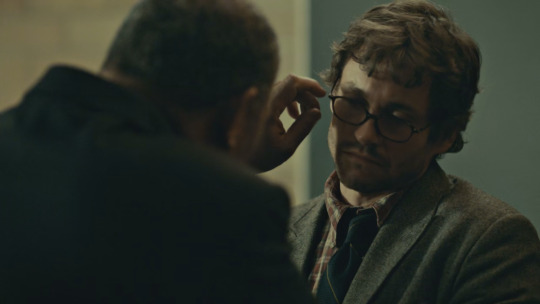
Jack exhibits a disturbingly dominant way of communication with Will. He corrects Will’s eyeglasses, the guy who he knows is not comfortable with any kind of interpersonal interaction, within the minutes of their chat and holds down his bag to slow down his moving on. He is trying to make sure that Will feels Jack is the alpha and also that deep down, Will does not have the option to not cooperate. And more Will gets convinced to help for one step, stronger Jack drags Will into it for one more.
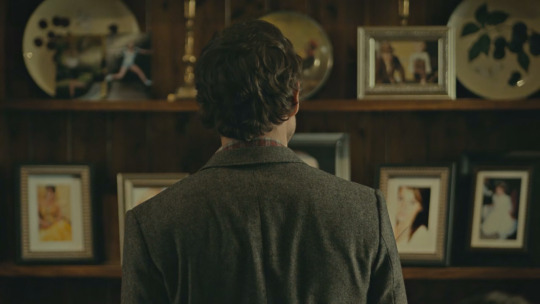
The first time we see Will interacting with any victim-related people, it is confusing. Being an empath and claiming that he can not only relate to narcissists and sociopaths but anyone, he does not seem to empathize much with the victim’s parents, cutting into the conversation about parents’ doubts on their daughter’s likelihood of being alive with a non-emotional, case related question. It almost makes you question if his ability to emphathize is just stronger with the dark side of the force than it is with the light one. Yes, the primer focus is to catch the killer and stop whatever malice is going on but after all, Jack came to Will with the need of help, so Jack must care about the case resolving more than he does. Yet, Jack seems more understanding of the parents’ feelings than Will, although Will is an ultimate empath. We even see Jack’s disapproval when Will cuts into the conversation. It is a brow mover.

Next, we get more insight about Will as he meets Winston. He finds him on the road roaming, tries to get close to him but cannot, so he drives all the way to his home to get something to lure him with and comes back to the dog. He is willing to go lengths to add a new dog to his pack, to his ‘family’, to his ‘social circle’. Something he is not willing nor comfortable to do for a person. Will's preferring an animal's company to a person's may say more than obvious. Afterall, he chooses Hannibal over Jack too, doesn't he?
Will who has already started to get traumatized by the case, is ambushed in the bathroom by Jack with an unforgiving mobbing, forcing ideas out of Will and stirring him up in the expense of his stability. Later on in his little chat with Alana, Jack’s intentions and priorities are further put into perspective. The way he talks about Will shows that for him, Will is more of a means to an end than an actual colleague. His insistence about “putting Will out there” despite Alana’s warnings and his admission of not being absolutely capable of protecting Will’s mental health just crowns that he does not genuinely care about Will. In fact, he even knows the risk of what he is doing, and he is trying to draw Dr. Bloom in to share, if not all together blame it on, the responsibility if something may go wrong.

We finally meet Hannibal in his office in a therapy session with his patient. The look Dr. Lecter throws when Franklyn blows his nose and places the dirty napkin onto the table… Up to this scene, we were not given any clue to suggest that Hannibal Lecter is a killer but after all, we do know who he is. And him being the first actual predator in the series we meet, we do not see him acting on brute violence or inelegant butchering. His first reaction depicted is unrest against rudeness. So the audience is welcomed into the mind of Lecter with an easily apprehensible act that can be shared by almost anyone. Almost to suggest that, this act of Franklyn’s may be enough to justify a wrath that may come upon him.
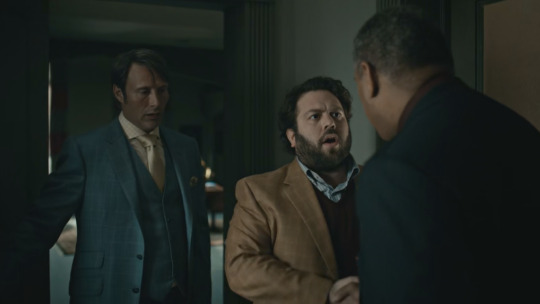
Jack shows up in Hannibal’s office unannounced and mistakes Franklyn with Hannibal. Hannibal, of course slightly annoyed, tells Jack to wait in the waiting room and invites him in with his own timing. Being a bossy and dominant guy he is, this takes Jack by surprise and it also tells us that there is an even stronger alpha here. So Jack realizes he cannot dominate Hannibal into his will like he did with Will. He may have to try something else. As Jack asks questions that are getting more specific and personal as they come, we see Hannibal getting cautious. Taking his scalpel into his hand and eyes widening. He lowers his guard only when he learns that he was referred to Jack by Dr. Bloom, his eyes visibly getting smaller, which are almost the only window to his thoughts anyway. So after seeing the sophisticated aura leaking not only out of Hannibal but everything around him, Jack chooses to sweet talk him into cooperation.
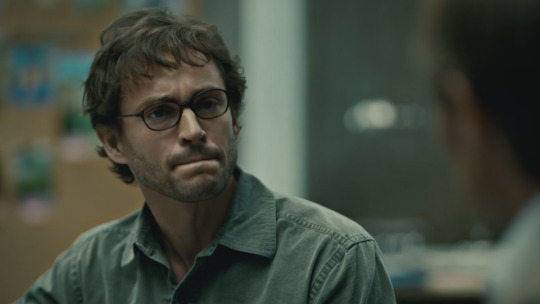
When Jack, Hannibal and Will first come together in a room, it is the first time in the show where Will makes such a long, non-blinked eye contact with someone, that being Hannibal. And we see mixed emotions and thoughts on Hannibal’s face. He is amused, intrigued and curious at the same time with the way Will thinks. He makes a quick analyze of Will which results in making him fling out of the room. Being the controlled, non-impulsive, strategic guy he is; even Hannibal himself is a little surprised with the sudden blurbing of his perception of Will. So maybe this first scene having Will and Hannibal together is another kind of first as well with both men doing something not typically them.
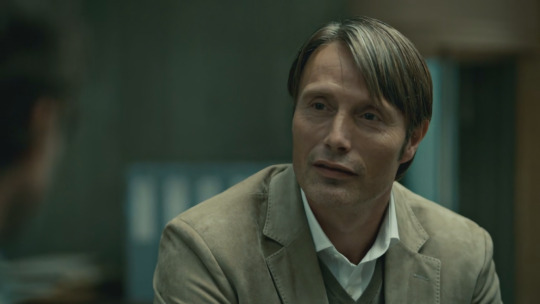
Hannibal, telling Jack that “he may help Will see the cannibal’s face”, he copies the crime of Minnesota Shrike. At the first look, this looks like an attempt of toying with the FBI and confusing them. But considering Hannibal’s last conversation with Jack, this feels more like a tribute, a helping hand for Will. Hannibal knows that Will would know that this is not the same killer the second he sees the crime scene. As Will later says to Hannibal, this was done to show Will a negative so that he could see the positive. So, we see from this point on that Hannibal’s wit does not focus on FBI, it does on Will. We see Hannibal eating and smiling, joyous of the fact that he now has an object of interest. Will imagining of a stag right after this, as stag will be the subconscious symbol of the Chesapeake Ripper / Copycat Killer before Will knows who he is and later when he does, of Hannibal; it shows that Hannibal literally entered his life and mind in more than one way.

Hannibal shows up in Will’s house very early and obviously very impatiently. So he does not only plan to interfere Will with being the Copycat Killer but through his ‘person suit’ as well. Feeding Will the meat of the girl he killed is also exciting for Hannibal as this manipulation game he has set to play with Will gets to be sicker for a normal human perception.
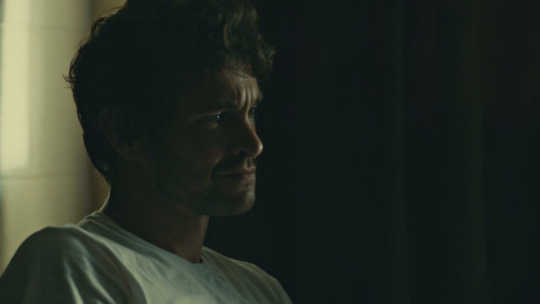
The breakfast scene is also the first time where Hannibal is looking for some ill-intent or killing inclination in Will, while Will denies having so. He wonders how much being able to empathize with killers say about Will’s own potential to do so. Hannibal suggests that Jack is treating Will as he is “a fragile little teacup, only used for special guests”. And that he himself sees him as “a mongoose that he would want under the house when snakes slither by”. He suggests that Will is not a pray that should be afraid to get hurt, that he is the predator. By that Hannibal does not only encourage the destructiveness Will may be trying hard to keep buried to come alive, but also the false perception that Will’s mind is strong enough to take any challenge Jack may throw his way.
Hannibal warning Garret Jacob Hobbs is literally setting the pieces in position of his will to get Will where and how he wants. He does not know what will be waiting in Hobbs’ house for Will but in the end, it does not matter so much since he just wants to see what happens.

When they arrive at the house, seeing Hobbs leaving his wife on the threshold her throat cut, Hannibal stands still. Is it because he is so confident that Will will be too frantic to ever look back and notice that, or is it because deep down he just does not feel like putting his person suit on in front of Will? I think both. When Will shots Hobbs and tries to tend Abigail on the floor, Hannibal walks in and sees Will caring hard for the girl. Hannibal’s face looks curious about what is going on but more than that, again, his focus is on Will more than it is on anything else. He sees all these humane emotions that Hannibal himself has always been somewhat stranger too on Will, those emotions that he thought, cannot come in a package with all the destructive ones. But maybe they can. And those emotions may even look nice. Because it almost does on Will. Although how the events would turn out Hannibal did not know, it was certain that the way he pushed things, there would be blood and there would be Will doing something that will change him one way or the other. After all, they have undergone a traumatic (for Will) and exciting (for Hannibal) circumstance together and it is a known fact that people who experience a significant situation together tend to develop emotional bonds. Maybe this was the least of what Hannibal hoped for. If that was the case, he got more than he wished. Will got to kill someone even if it was for a just reason and there happened to be an orphaned girl that Will desperately bonded the moment he killed her father, who maybe a manipulative tool for Hannibal in his game. The last scene where Will finds Hannibal holding Abigail’s hand in the hospital room highlights this perfectly. Now, Hannibal and Will has a mutual asset that Hannibal may use to draw Will closer to himself despite of Will’s initial reservations to do so.
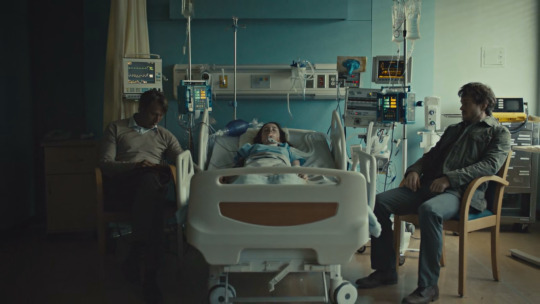
#hannibal#hannibal lecter#will#will graham#hannigram#brian fuller#nbc hannibal#hannibal meta#hannibal analysis#hannibal and will#mads mikkelsen#hugh dancy#murder husbands#will and hannibal#jack crawford#hannibal loves will#will loves hannibal#aperitif
43 notes
·
View notes
Text
An interview with music journalist Paul Zollo. I believe this is from 2000. I’m a sucker for Billie Joe talking about his songwriting process.
By PAUL ZOLLO
SEVEN STORIES ABOVE THE SUNSET STRIP in Hollywood is the Chateau Marmont, an old hotel rife with the ghosts and scandals of Hollywood’s recent and not-so-recent past. Famous for the elegant, old-world discretion it affords all its guests, for decades it’s been a safe harbor for stars seeking to circumvent the squall of media surveillance. It’s where John Belushi died, sadly, back in bungalow three, and where Jim Morrison wrecked his back by swinging Tarzan-like from the roof, using a drain pipe as a vine. Every star, it seems, from Chaplin and Bogart to Dylan and Lennon have hidden out here while in Hollywood. “If you must get in trouble, do it at the Chateau Marmont,” Harry Cohn, the first boss of Columbia Studios, once told William Holden.
So it’s an appropriate setting for Billie Joe Armstrong, the lead singer, songwriter and guitarist of Green Day, to be holding court. Armstrong and the band are no strangers to scandal – they’re the ones who started a mudfight that bordered on insurrection at Woodstock II; they’ve been outspoken about their fondness for drugs and alcohol; they’ve been especially harsh in their expressions of scorn for many other bands; and they’ve frequently “redecorated” hotel suites, bars and Tower Records stores alike with a flair for creative demolition that brings to mind the heady decadence of the Doors and others.
In fact, parallels between Armstrong and Jim Morrison abound. Like the leader of the Doors, Billie Joe is the creative catalyst of his group, but only writes within the fold of his fellow musicians. Like Morrison, Armstrong has been known to walk on the razor’s edge of life, bringing an authentic, expansive passion to every song he sings. He’s also been known to match his inclination to strip his soul bare in song by taking off his clothes in concert. The difference is that when Jim Morrison did it, all hell broke loose, the country was shocked and the singer was arrested. But when Billie Joe does it, he gets acknowledged on the MTV news, Kurt Loder smirks, and that’s about that. Being shocking these days is just not like it used to be.
‘It’s something unpredictable,
But in the end is right
I hope you had the time of your life.”
From “Good Riddance (Time Of Your Life)”
By GREEN DAY
Few things seemed more unpredictable than the thought that Green Day would have a Number One hit with a pretty ballad of all things. Even more unlikely would be that the song, officially entitled “Good Riddance” but better known as “Time Of Your Life,” would become as ubiquitous in the American consciousness as the Star Wars theme. Used on “Seinfeld,” two episodes of “E.R.,” and extraneous sporting events (as when Mark MacGuire became the king of baseball’s home-run derby), Green Day’s ballad quickly became more famous than Green Day itself.
“Good Riddance” now stands alongside Springsteen’s “Born In The USA”, Randy Newman’s “I Love L.A.” and Sting’s “Every Breath You Take,” as one of the nation’s most misappropriated hit singles. Like all of those songs, which are much darker if you examine their core than the mainstream ever seemed to recognize, “Good Riddance” actually comes closer to condemnation than the kind of nostalgic celebration for which it’s been used:
“Tattoos of memories and dead skin on trial
For what it’s worth, it was worth all the while
I hope you had the time of your life. “
From “Good Riddance (Time Of Your Life)”
By GREEN DAY
Though Green Day’s presence on the world stage shifted from popular to astronomical because of this song, many of their old fans felt alienated by their secret heroes’ injection into the mainstream. “[`Time of Your Life’] was a drastic change for us to record,” Billie Joe said. “We knew that there were going to be some people that weren’t going to like it because it’s not a 1-2-3-4-Let’s-go-punk-rock tune. Mike [Dirnt] said, `This is a real beautiful song, who cares what people think?’ So we just went for it. Long term thinking, you know. Punk is not just the sound, the music. Punk is a life-style. We’re just as much punk as we used to be.”
Of course, definitions flow fast and fluid, as purveyors of punk, such as Armstrong, play along the borders of pop. “A lot of punk rock bands are always trying to be so hard all of the time,” he said. “Macho brutality doesn’t necessarily mean you’re a good songwriter. I think that some of the Beatles’ songs are way more punk rock than most punk songs written today. Like the song `Yesterday.’ It’s such a bittersweet song. “
Billie Joe was born in 1972 and grew up in Rodeo, a little Californian town just outside of Berkeley. His father and uncle were both jazz drummers. “I was a guitarist in a house of drummers,” he said. His father died when he was ten, the same year he met a neighbor named Mike Pritchard who shared his passion for making music. Together they decided to drop out of high school to start a band, which they called Sweet Children. It was a decision Billie’s mother encouraged. “My mom sort of let me do whatever I wanted,” he said. “When I quit school, she thought that was a good idea because I was really ambitious to play. So I started touring when I was seventeen.”
Pritchard changed his name to Mike Dirnt, Tre Cool replaced Al Sobrante as official drummer, and they called themselves Green Day, a Bay-area euphemism for a day spent smoking pot. Their first release was an indie EP called 1000 Hours, after which they signed with Lookout Records to make 39/Smooth and Kerplunk. In 1994 they ascended to the major leagues, signing with Reprise, and released Dookie. They soon became an MTV mainstay, and their mudstorm performance that year at Woodstock cemented their reputation as a band on the edge. Three more singles followed, as did sales of more than eight million albums worldwide, and a Grammy Award for Best Alternative Music Performance.
Insomniac was released in the fall of ’95, but instead of going on a European tour as planned to launch it, they elected instead to stay home and write and record more songs. The result was the most popular, and most critically acclaimed album of their career, Nimrod, which included “Time Of Your Life.”
Warning was the new album at the time of this interview, and the impetus for Billie to talk. Inspired by the rich lyricism of Springsteen’s The River and Dylan’s Bringing It All Back Home, Green Day went away for a while to write and play the songs before recording them. It’s their first self-produced and most sonically adventurous album to date, blending layers of acoustic guitars in with the electrics, and with some unexpected detours, such as the German beer-hall stomp of “Misery,” and the Clash-meets-Kinks pop-punk of the title song.
“Caution police sign you’d better not cross
Is the cop or am I the one that’s really dangerous?
Sanitation expiration date question everything
Or shut up and be a victim of authority
Warning, live without warning…”
From “Warning”
By GREEN DAY
Today Billie Joe is ensconced within an overstuffed burgundy couch in his hotel suite. Although he’s drinking coffee from china cups, and eating fresh fruit and croissants from a silver tray, he’s remained loyal to the punk lifestyle, and is wearing a black t-shirt and baggy jeans. Prior to our talk, rather than linger in the luxury of his suite, he ducked down into the hotel’s bleak back stairway for a cigarette. Though he’s undeniably a star of the first degree, he’s uncomfortable with such designations, and shuns all the trappings of stardom. As opposed to the Ferraris and Lamborghinis driven by his peers, an old Ford Fairlane remains his vehicle of choice. He did admit to one extravagance, however, which he revealed somewhat sheepishly. “As soon as I could afford it,” he confessed, “I went out and had it primered.”
BLUERAILROAD: You write all the songs together in the band. Do you start songs on your own and bring them in?
BILLIE JOE ARMSTRONG: Yeah, sometimes. I’ll come up with the song with the chord changes and the lyrics, and then I bring them into practice, and then we sort of restructure them together. I like to come in with a tune. I’ll just play guitar and sing it for them, and then we start to learn it. And as soon as we start to learn it, we can make changes and come up with a different structure. Move the chorus around, make the verse a little longer. That kind of thing. I definitely like to think of it as a collaboration between the three of us.
Do you always change the songs?
Well, we have a lot of songs. There have been some that I have brought in and nothing really needs to be done. Sometimes I’ll suggest a part that needs to be worked with, and we’ll try some different things. And then they’ll write their bass-lines and drum parts around it.
Do you ever have a problem sharing credit on songs you wrote alone?
Well, we’re a band. We’ve been able to stick through a lot of years because the three of us support each other. The songs come from Green Day, and I like to stick by that. We like to just keep things equal in the band, and I think it’s what has made our band healthy over the years. We give each other respect. There is no one who stands out more than the other one in this group. Especially since we’ve known each other for so long.
These days do you write on electric guitar?
No, on acoustic. I have a Silverine Harmony. But it sounds good. I just have it around the house, so I’ve written most of the songs on it.
Do those songs then shift a lot when you bring them to the band, and play them on electric?
No, because I always have it in the back of my head about the dynamics of electric guitar and drums and bass. Between me and Mike and Tre, I always have that dynamic in my head – what am I going to bring to the table that they’re going to be able to play, and which will have our certain energy. I always keep our energy and our music in mind, sort of subconsciously. But I think that’s the beauty of this. That not only can I play these songs with a band at full volume, but also that I can play them on a cheap, acoustic guitar. And it can have the same kind of impact.
“Warning” would work that way.
Yeah, it does. That kind of came all together at the same time. I think lyrics on this record were really important to me, and to have a well-rounded record as far as what kind of topics I wanted to write about, and sing about. That was one of those songs that seemed to just write itself. It just came really naturally.
Is that unusual for you, the feeling that a song writes itself?
Well, I try to go for inspired moments. But if I want to write a song that sounds like it has a pop kind of edge to it, I really want to be able to say something. I have to say something – it’s vital for me. I can’t just write something that would be sugar-coated, and have a pop song with nice lyrics that go along with what everyone is doing on the radio these days. It’s very important for me to have a message that goes along with the writing. So, you know, what comes to mind for me is a song like “The Ballad of John & Yoko,” where [Lennon] had this really nice sounding song. But the lyrics penetrate like a knife. “They’re gonna crucify me…” That’s kind of nice way — nice, I mean, in an oxymoronic sense – to put forward something you want to attack.
You’ve done that in many songs.
Yeah, I think it adds a sort of demented side a little bit, sort of like a clown in a circus. But it also makes the lyrics a lot stronger. If you take a band like Rage Against The Machine, the music is aggressive, and the lyrics are aggressive at the same time. And I love Rage Against The Machine, but sometimes it feels like you getting bombarded by someone’s else’s point of view. The person is not telling you to think, but what to think. And that’s one thing that I really wanted to come across in the music and the lyrics. To think about the world around you, and not what to think, so to speak. And at the same time, to have my opinions coming through at the same time.
Are you always clear about the meaning of a song while writing?
No. That’s hard. I mean, sometimes I’ll have things in the back of my head that I want to write about. But I never want to come across as pretentious or preachy. So I just wait for my thoughts to settle. To a certain extent, you have to be a little self-righteous and I think it’s healthy. Especially when, nowadays, there’s so much stuff that is about decadence. And when it comes to rebellion, a guy who has a Rolex watch and is driving around in a Porsche, talking about that he really wants something to break, I don’t really think of that as rebellion, I think of that just as a decadent rock star.
Do you have any kind of routine for songwriting?
Last record I was just sort of pounding songs. Anytime I had any inkling of an idea of anything at all, I would just grab my guitar and play it and work on it no matter what the song was like. Whether it was inspired or I just got drunk and started playing. But this time I waited for inspired moments. And I think it took me a long time just because of that. I wanted everything to sound refreshing, and something that would make you want to turn it up a little more.
Did you have times when you tried to work and nothing would come?
Oh yeah. You get frustrated. You feel, “Man, I just want to write a fucking song.” And sometimes it���s just not there. And you can’t dwell on that when that happens. You have to just let it go.
I don’t ever want to try to outdo myself. I feel like if you try to outdo yourself from the last thing, instead of just working on your inspiration, I think the music kind of suffers a little bit, sometimes. Sometimes I’ll just get a very general idea about the kind of song I want to write. And I’ll just sort of store it in the back of my mind and see what comes out. It can come out in five minutes, it can come out in five days, five years, five decades.
Are there songs you worked on for years?
Yeah. “Longview” was one that we worked on for years. We knew what we wanted to write about. I told Mike to write a bass line and one day I came home. This is when we lived in the same house. He had just dropped some acid (laughs) and he said, “Listen to this.” And I said, “Okay, I guess it sounds good.” He came up with this bass line that really worked well, so we ended up practicing and came up with the song.
Are there many songs you start that you don’t finish?
Yes. And I’ll just wait for the right time and the right place for it. There are some songs I finish but then I think it’s not right for the record we’re working on. There’s a couple of songs like that off of Nimrod. “Time of My Life” had been written a couple of years before.
That song resounded in enormously with the public. Was it just a fluke, or did you sit down with the intention of writing that kind of song?
Both. I think that anyone can sit down and write a song. Whether or not it’s any good is another thing altogether. You know, there’s no school you can go to that will help you learn how to become a songwriter. But you can sit down and do it. Especially with rock & roll. But to put something down that is actually really great, it does go beyond you a little bit, and sometimes it takes patience.
Do you write all the time?
Yeah. Whether it’s good or bad, I don’t know. Or if it’s appropriate for what kind of idea or sound that we want to get across on the record.
Where do you think the great songs come from?
I don’t know. I really don’t. It comes from somewhere deep down inside of you that you didn’t even know existed. It’s kind of like seeing a shrink or something. (Laughs) There can be a lot of anger, or sadness, or joy, that you had but you didn’t even know you really had – but it can all come out. You feel a connection with it, and so other people can, too. You strike a nerve.
Does songwriting get easier the more you do it?
I think so. I think you definitely learn more as you go. I think you find new ways to motivate yourself. You test yourself a little bit more and see what comes about. And you challenge yourself in new ways to see what comes out. You learn new ways to get the engines going. But whether or not it does get easier, it’s what I do. And I love doing it.
#'I don’t ever want to try to outdo myself'#HE'S SUCH A FUCKING LIAR#at least he knows the music suffers from it#BUT HE'S A GODDAMN LIAR#article#articles#interview#billie joe armstrong
18 notes
·
View notes
Text
The Good Place Primer
Now that The GOT Place has gotten into the parallelogram aspect of the story, I thought it would be helpful to provide a primer of The Good Place. Spoilers are below the cut, but if you get a chance to watch the show, I really, really hope you do! It's a wonderful series that I'll recommend until my last breath.
But if you want spoilers, well, here are your spoilers:
The Good Place is a story about the afterlife and all its complications. In the original television series, we follow four humans (Eleanor, Chidi, Tahani & Jason), who have all died and made it to a neighborhood in the titular Good Place, as opposed to the Bad Place, where people get tortured for eternity.
To keep everything in order, the residents of the the Good Place are placed into neighborhoods that cap out at 300ish people. The separate neighborhoods are built by afterlife architects. The one that Eleanor, Chidi, Tahani and Jason end up in was made by a Good Place architect (Michael) and maintained by a walking Alexa/Siri/Hey Google not-a-robot (Janet).
The problems begin when Eleanor realizes that somewhere along the way, mistakes were made and she was mixed up with someone else. She doesn’t belong in the Good Place and the entire first season encompasses her attempts to covertly earn her place, as to avoid unending torture. Naturally. Chidi, who was an ethics professor, teaches her on how to be a good person when she confesses her real identity.
Ethics are a HUGE part of the show, with Kant and Plato and all these major philosophy icons getting mentioned, as well as discussions as to how people should do their best for themselves and for each other.
Here’s the thing - THE BIG SPOILER -
(last chance to back out)
Okay.
They’re all already in The Bad Place.
It’s a torture experiment, specifically made for the original four humans aka the eventual Soul Squad. On Earth, Eleanor was selfish and unkind, Chidi indecisive and wracked with self-doubt, Tahani elitist and concerned only with her status in the world and Jason had many issues, but being from Florida alone doomed him. Everyone else in the neighborhood is a demon in disguise, including Michael.
Janet is Janet, a kickass cinnamon roll who was stolen and meant to function in a real Good Place neighborhood and decides to stick around to help the four humans when she learns the truth. She’s wonderful.
So, as it turns out, every action a living person takes on Earth accumulates afterlife points. Those who meet a high threshold make it into The (real) Good Place. Very, very few make it in - which is a fishy thing they twig onto later.
Through shenanigans and banding together, the Soul Squad convinces Michael and Janet to join with them in an effort to earn spots in the actual Good Place. This takes some time, and it includes them meeting the Judge of the Universe, Hydrogen. Gen, for short. (Played perfectly by Maya Rudolph, btw.)
Michael, who always despised humans, and believed them incapable of change, learns the opposite is true and that all four people became better versions of themselves during their time in his torture neighborhood.
Because of this, he suggests to Gen that the Soul Squad get sent back to Earth, to get a chance to improve their point totals. They do, circumventing their original deaths and moving on with a new lease on life. None of them remember their time in the afterlife, but they each make great movements in becoming better people.
Of course, everything goes wrong.
It all comes down to the fact that no one has gotten into The Good Place in five hundred years. Turns out that the point accumulation system is broken and you can do one good thing (aka bring your mother flowers) but lose points for all the things that are associated but you can’t control (the effect of long distance transport on the climate, the pesticides used, the underpaid workers who cultivate the flowers, the crooked CEO who runs the company and is getting your money - you get the gist). Your good and kind choice ends up leaving you in the negative digits.
In the end, a decision is made to completely reboot the afterlife system itself.
The architects from The Good Place and The Bad Place join forces, paired up to run individual simulations on every person who has died. Everyone gets a chance to improve themselves in the afterlife, away from all the caveats and unknown factors on Earth that would otherwise doom them. Only then are they sent to either place for eternity.
The original four, Michael and Janet save the universe, basically.
I do hope, despite these spoilers, that you watch this show. It is heartwarming and so incredibly funny and the series finale is absolute perfection. Perfection. I sobbed so much when I first saw it and it still makes my chest feel all funny. The way this show makes you think about what humans are to one another, the beauty in the world and doing good for the sake of goodness - there's absolutely nothing like it.
Notable Characters That Show Up In The GOT Place:
Tahani Al Jamil - Former It Girl, Heiress, Model, Best Friends With Beyoncé, texts with the Dali Lama, etc. Her talent for name dropping is unparalleled. In the afterlife, Tahani learns to actually care about other people because it’s the right thing to do, as opposed to making her look good. In reflection of that, she chooses to leave The Good Place and become an architect for all the incoming souls, the ultimate way to selflessly help others.
Gen (The Judge) - A higher being unconcerned with the ins and outs of what is right or wrong, but will hear you out if you’re entertaining enough. Obsessed with Timothy Olyphant. I cannot emphasize how spectacular Maya Rudolph is in such a small role.
Shawn - Demon. Formerly Michael’s boss and current frenemy, but he will never, never, ever ever ever everevereverever admit to a soft spot for anyone.
Vicky - Demon. Takes over as Head Architect from Michael when it turns out she’s surprisingly well suited to the job. Drama queen. Terrible singer, but doesn’t let that discourage her.
Glenn - Demon. Hapless, goofy, the second demon after Michael who is willing to say that maybe humans aren’t entirely garbage. Kind of a sweetheart. Shawn’s favorite whipping boy. Bad Place Architect who helps train Tahani and (in the story) becomes her partner in afterlife tests.
Beadie - Angel and Good Place architect who trains Tahani. V nice. V bland, as The Good Place staff tends to be.
Todd - Demon/Bad Place architect/Lava Monster. Pretty chill dude, though.
Jeremy Bearimy - Often referred to as a Bearimy. Not a being, but a concept. Time in the after life does not run in a straight line with a strict beginning and end, but in a series or loops and twists that circles back upon itself. It looks like this:
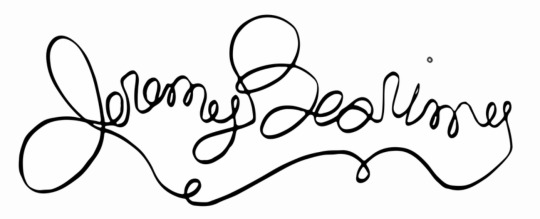
The dot above the eye is not a typo. Don’t try to fully understand it, though. Chidi briefly broke his brain in his attempt to do so.
Thank you for reading and I hope you give the show a chance! ❤️
7 notes
·
View notes